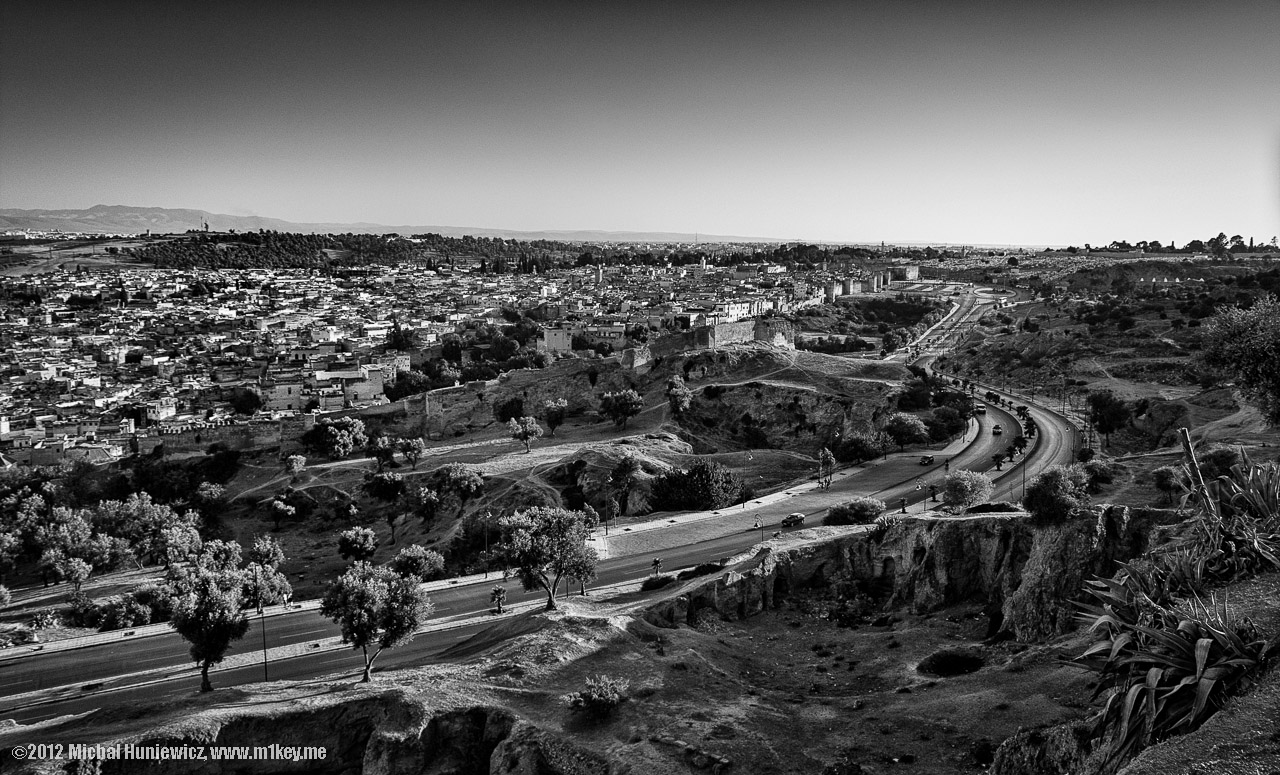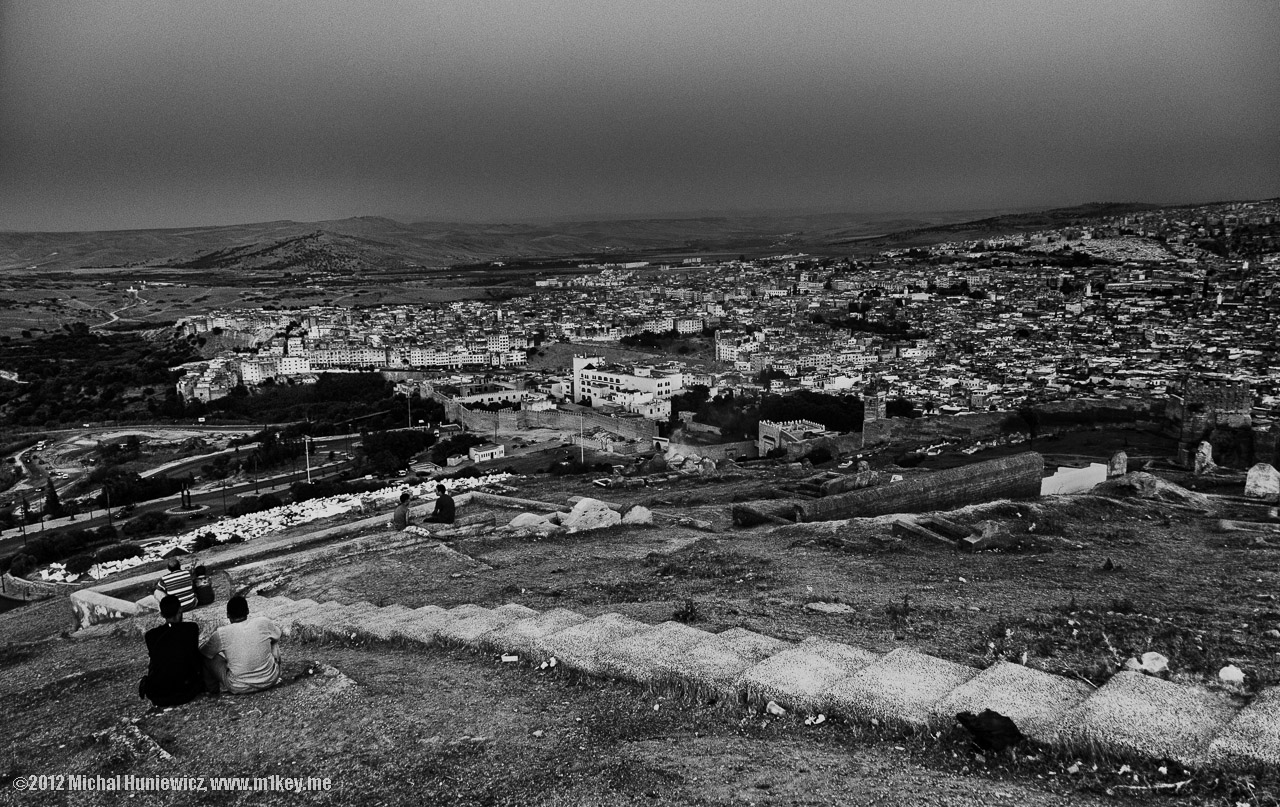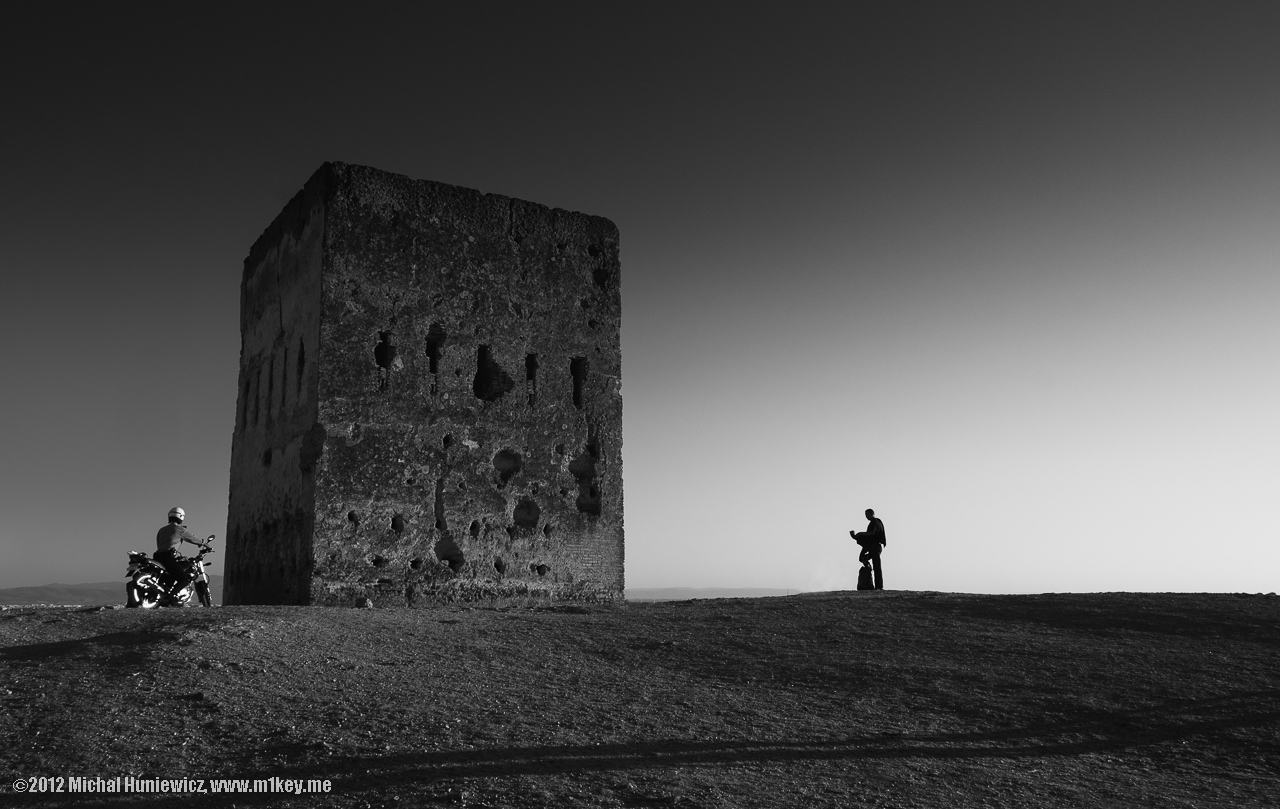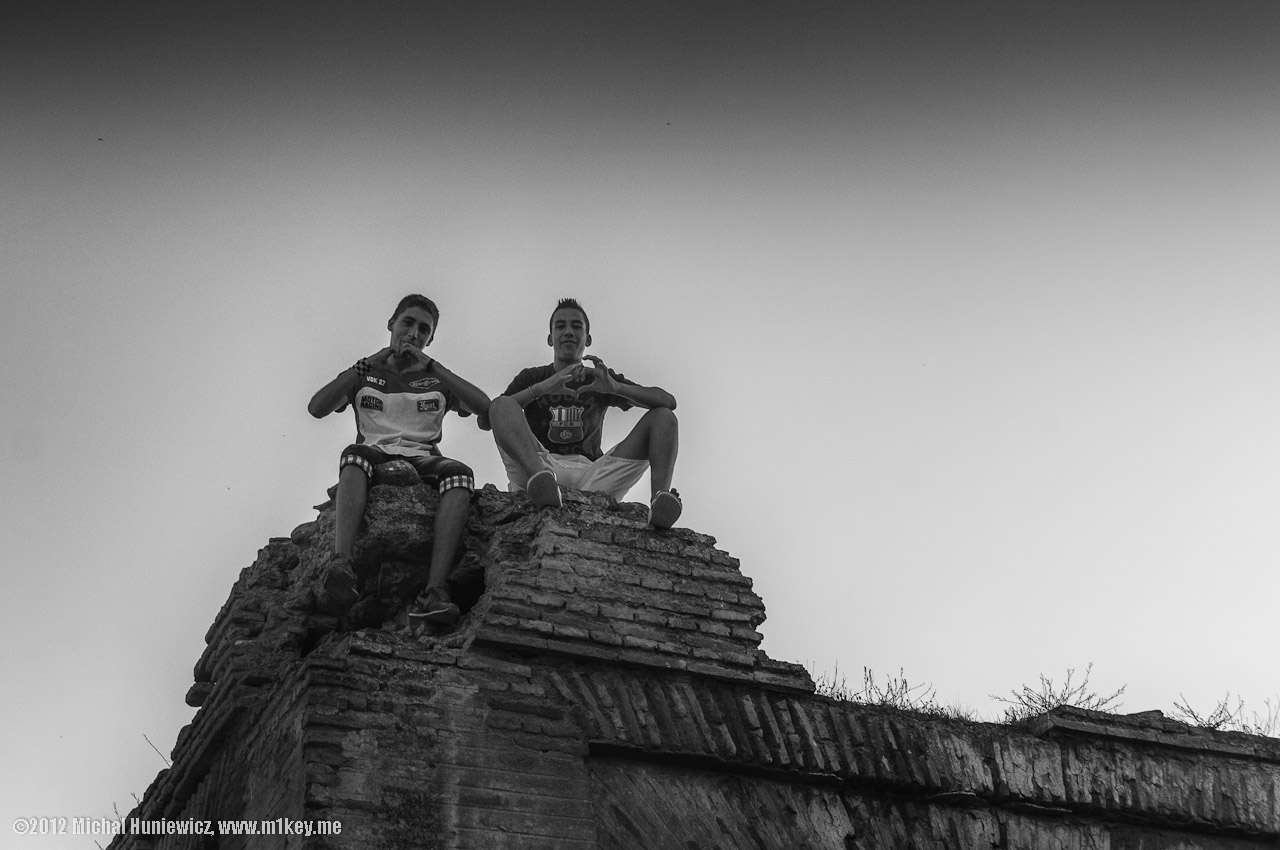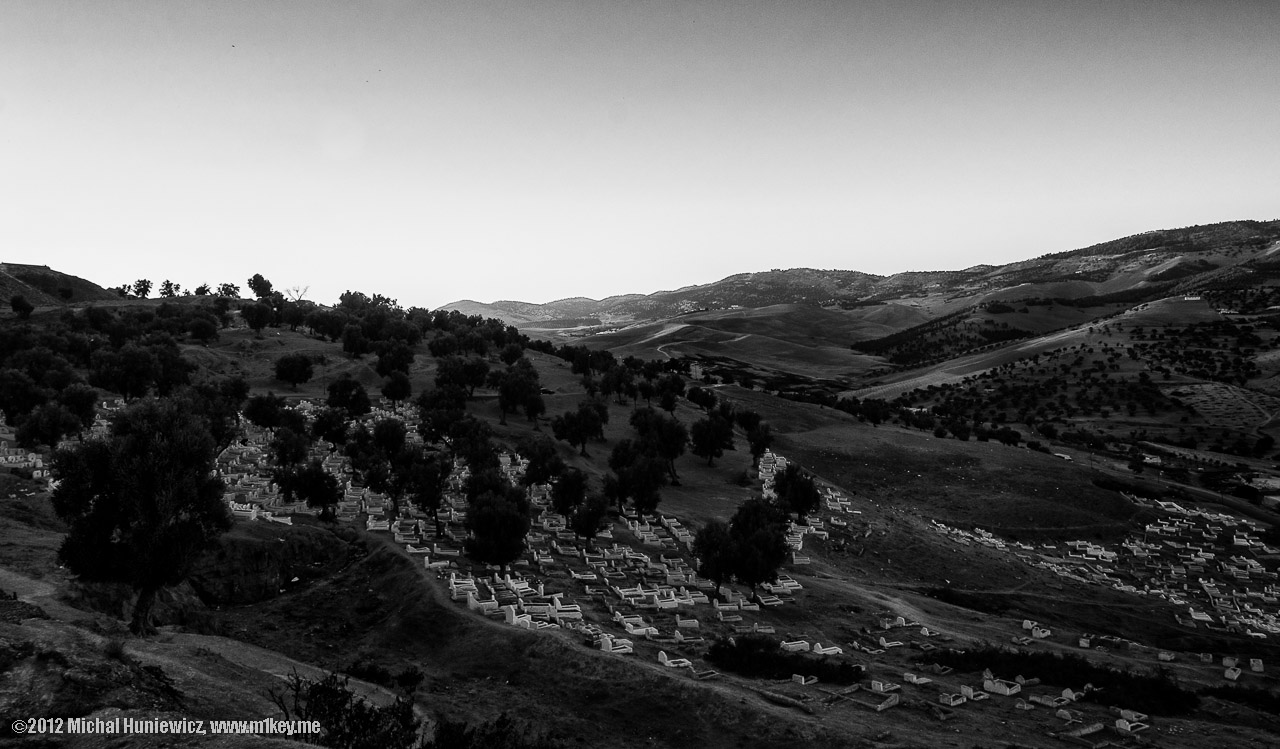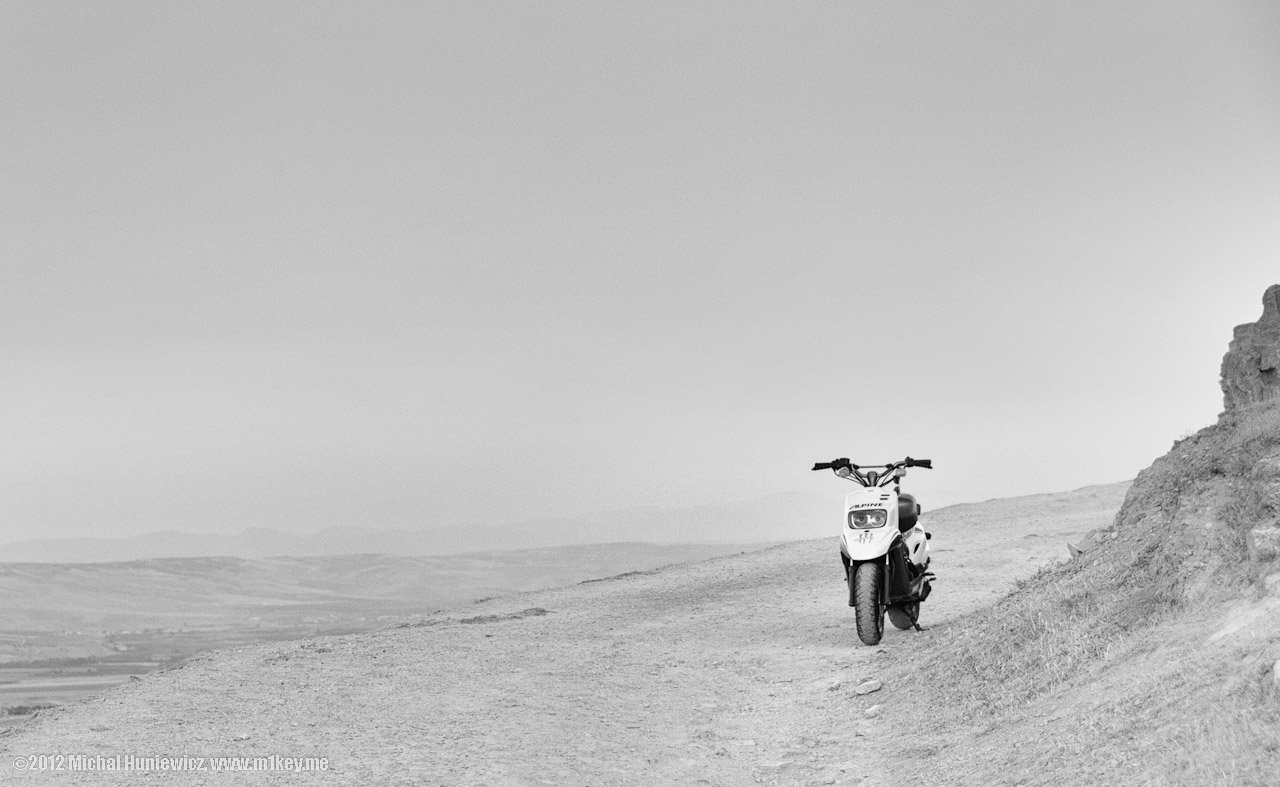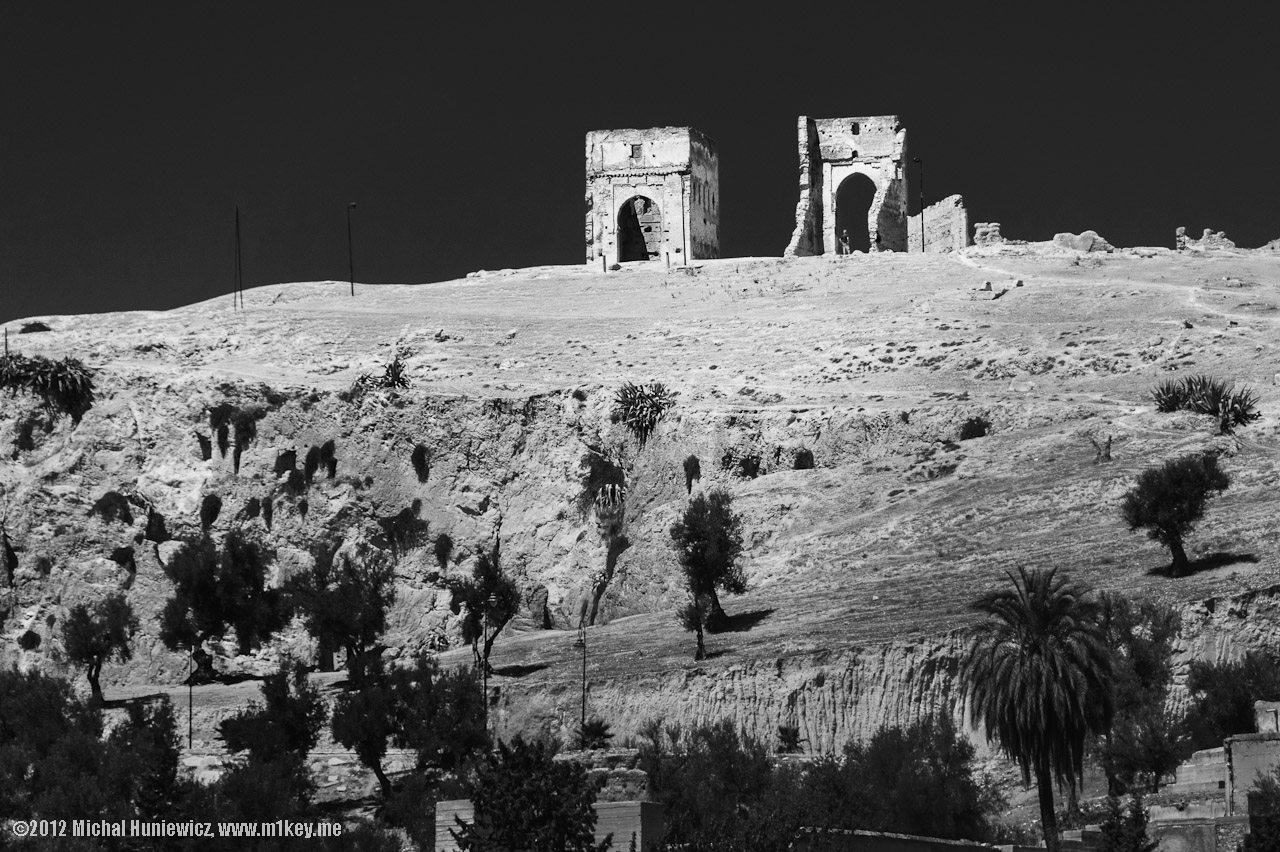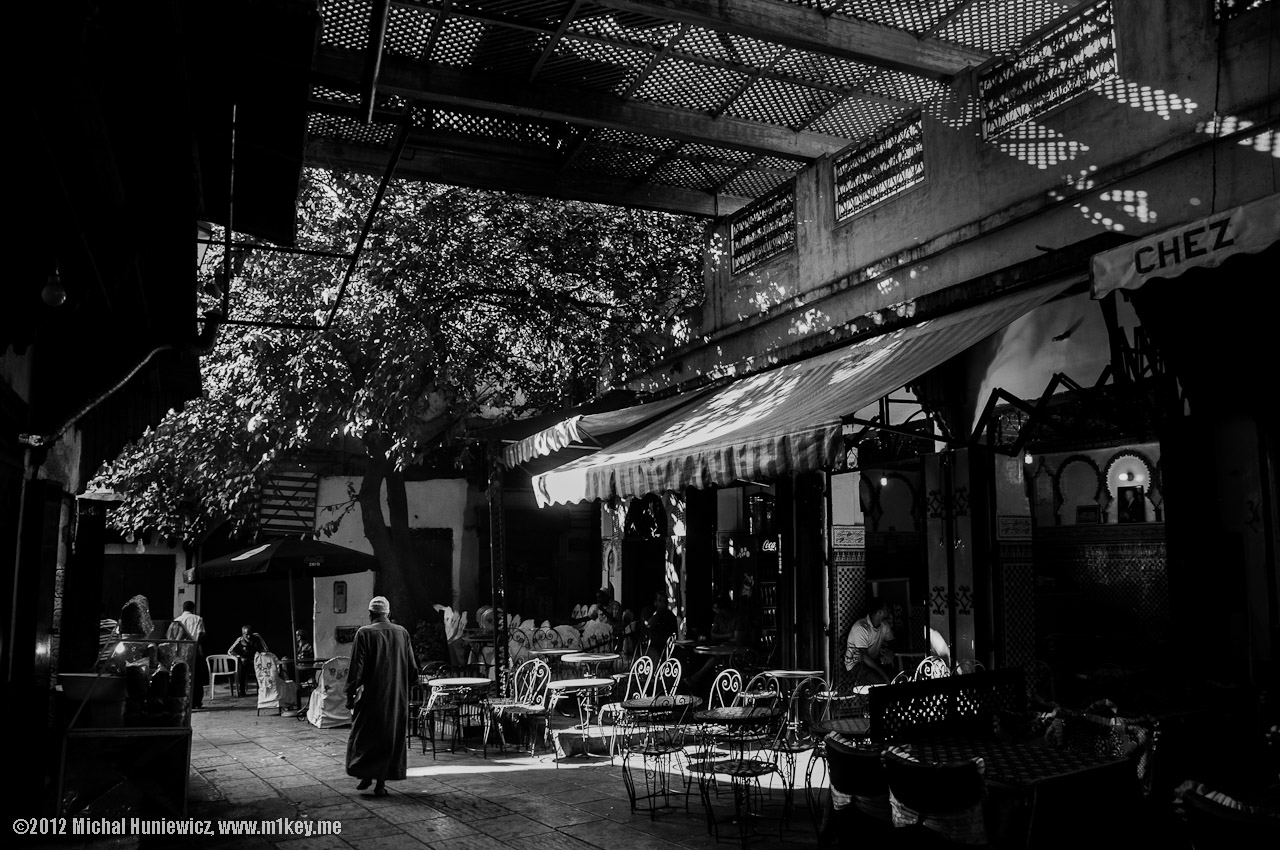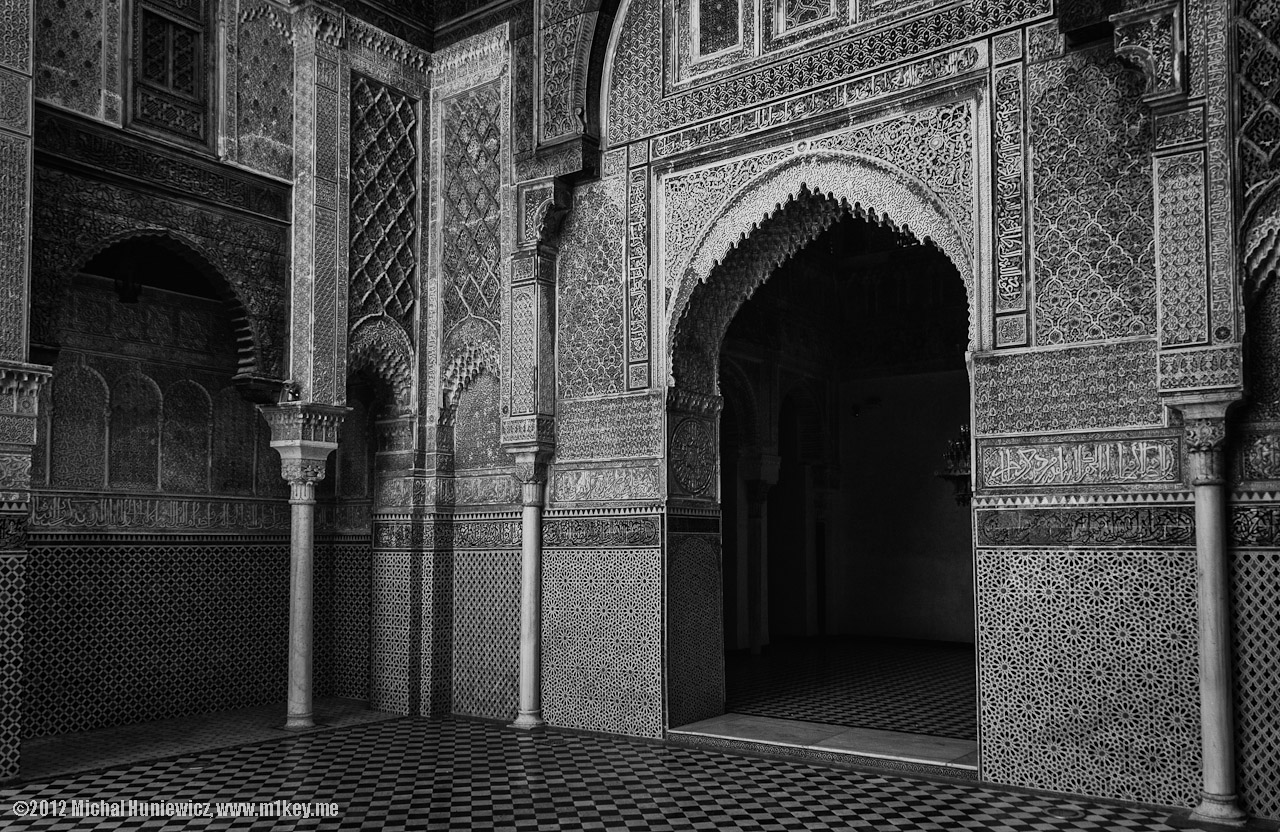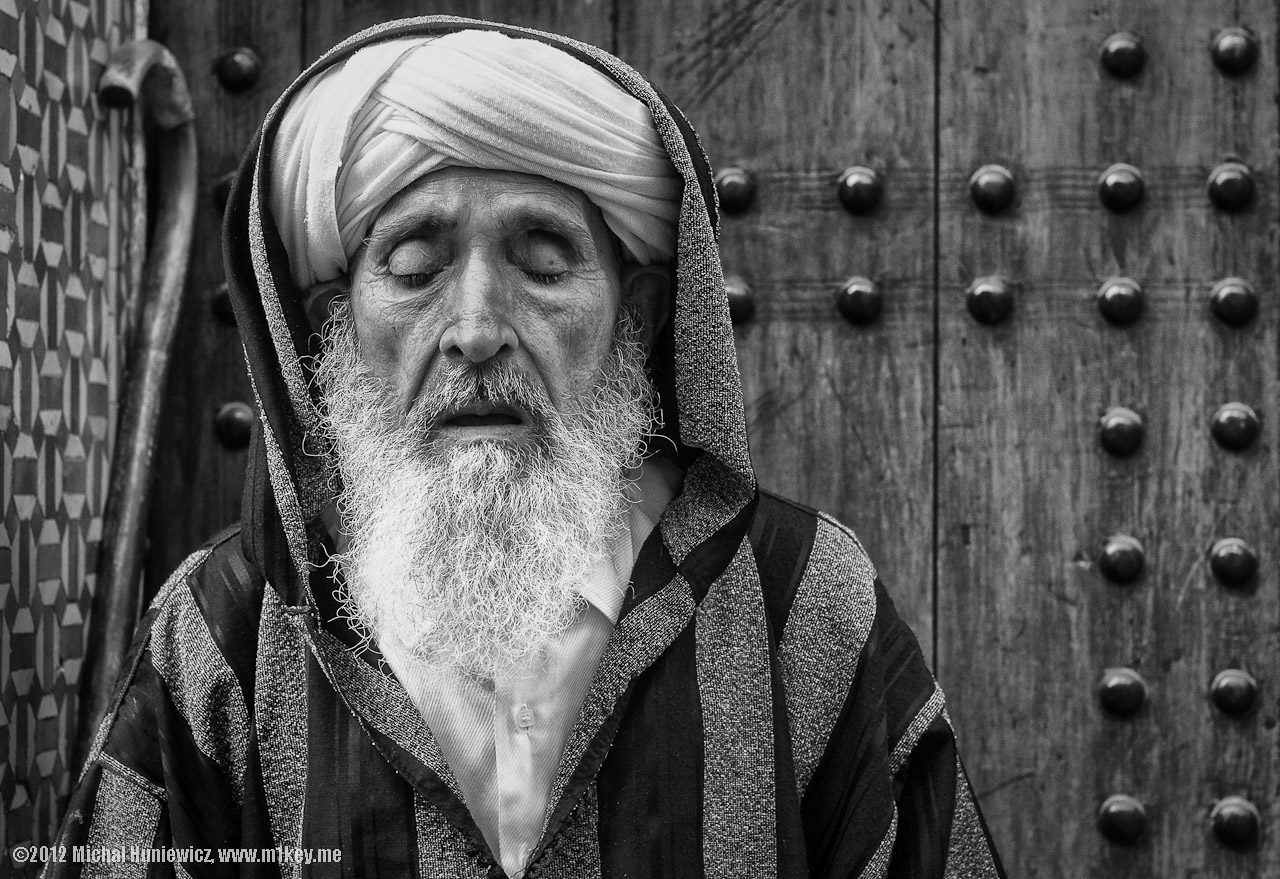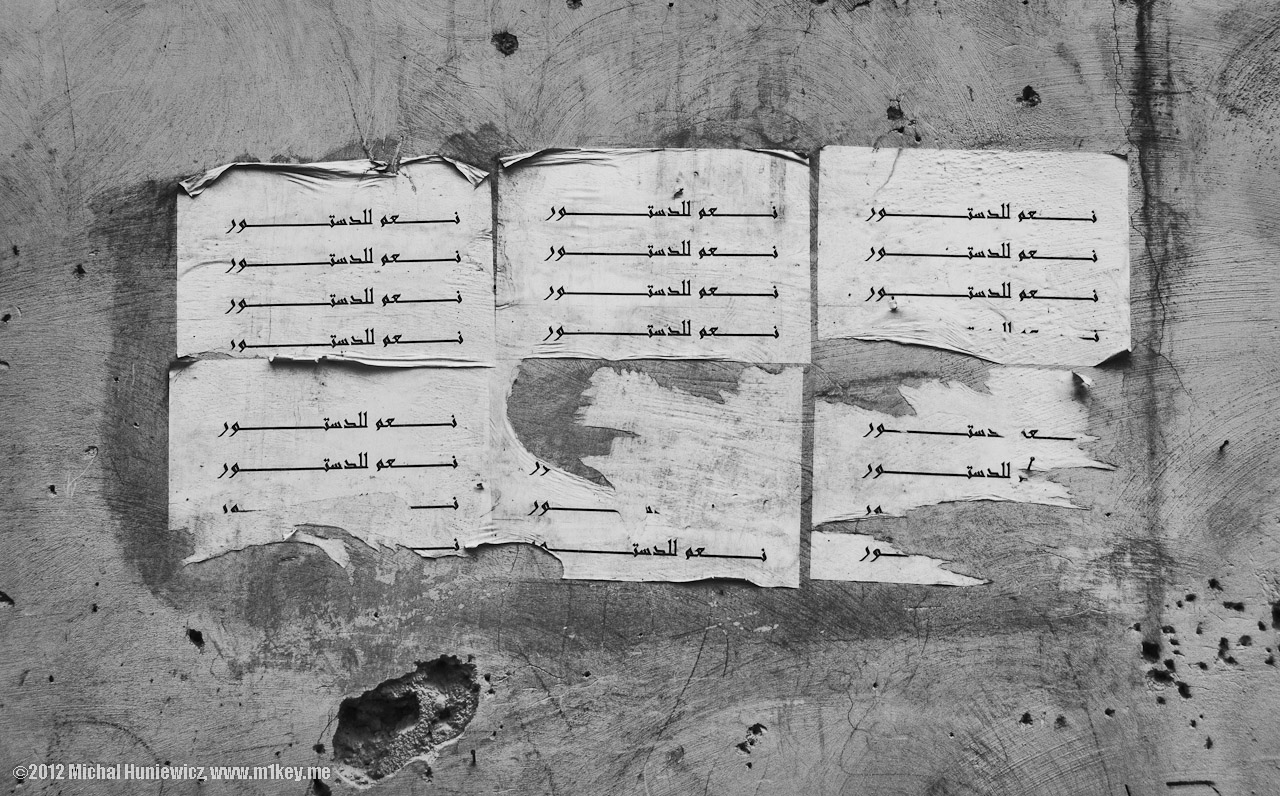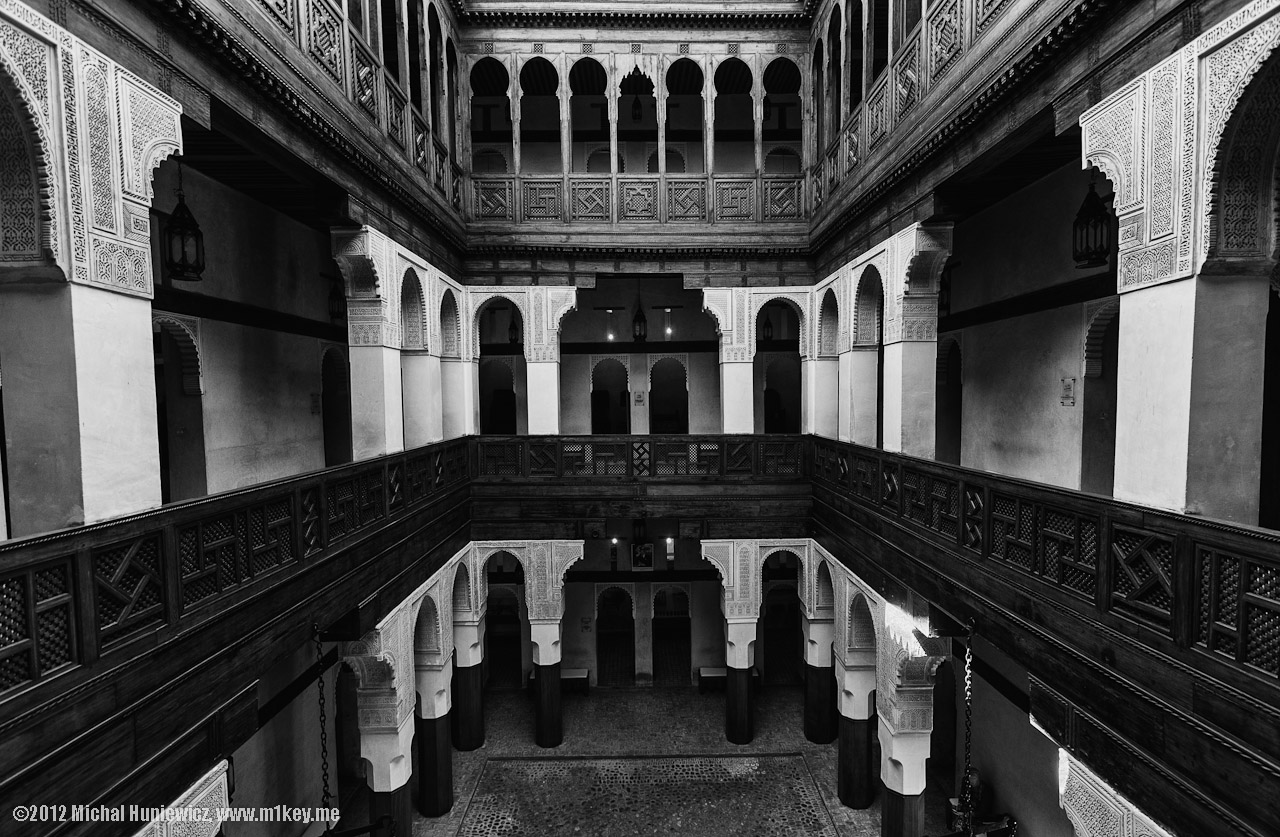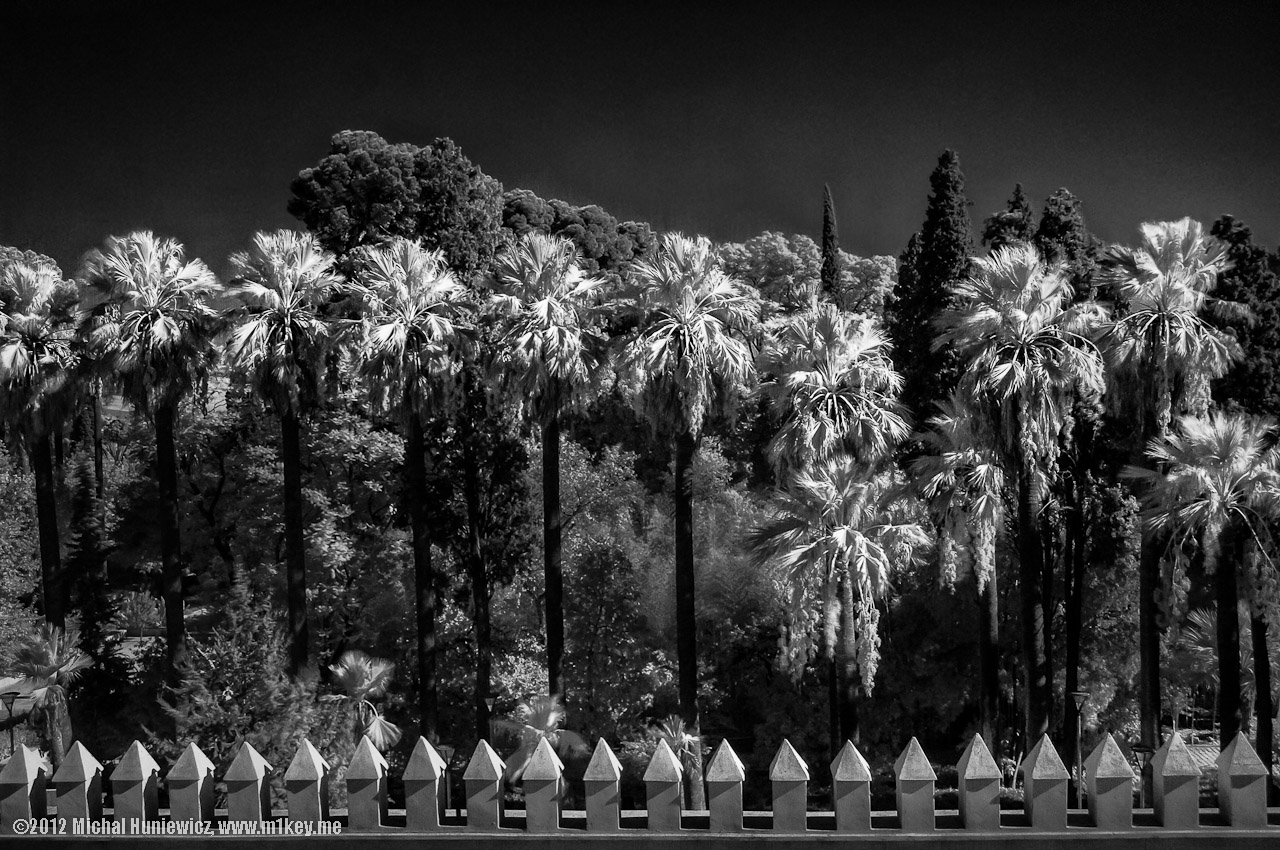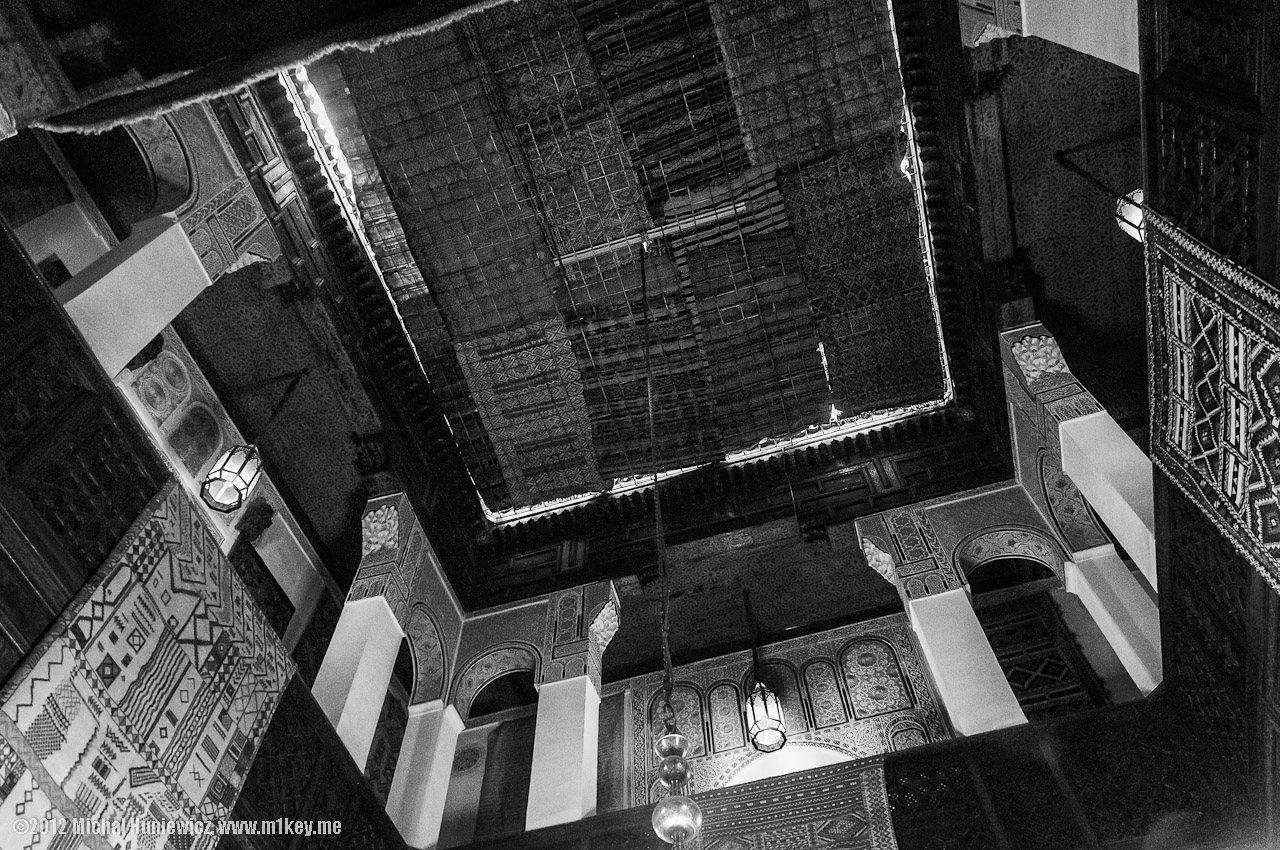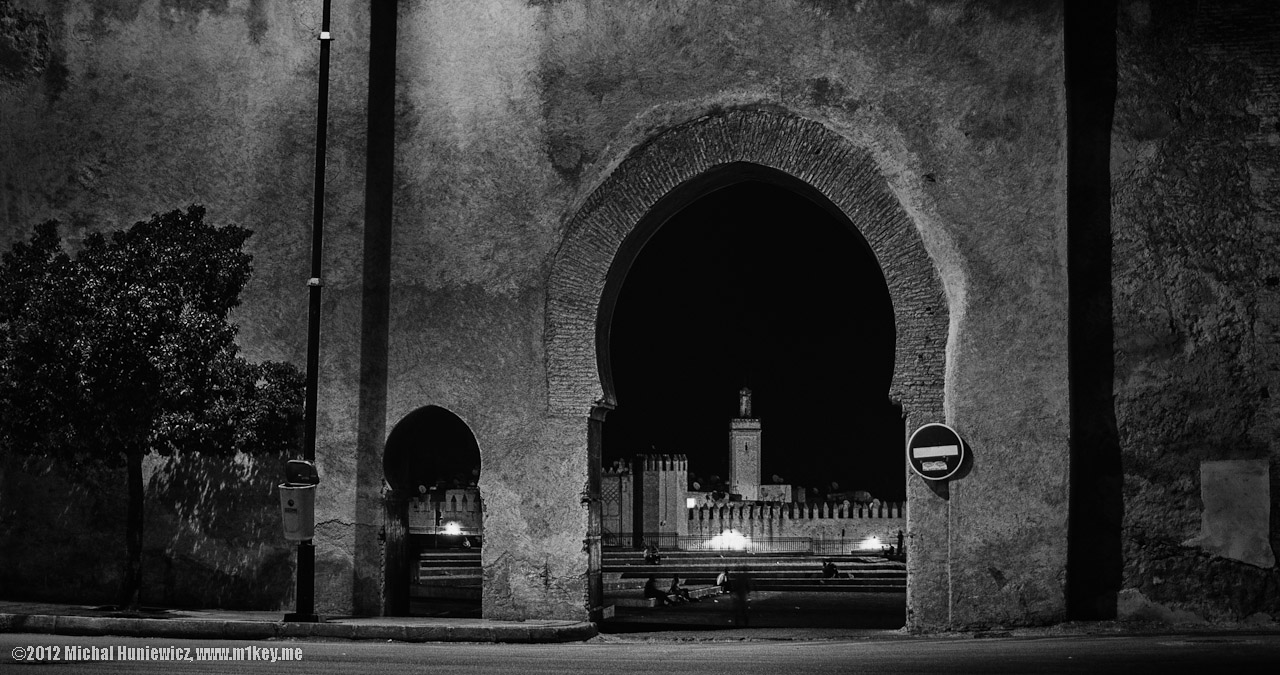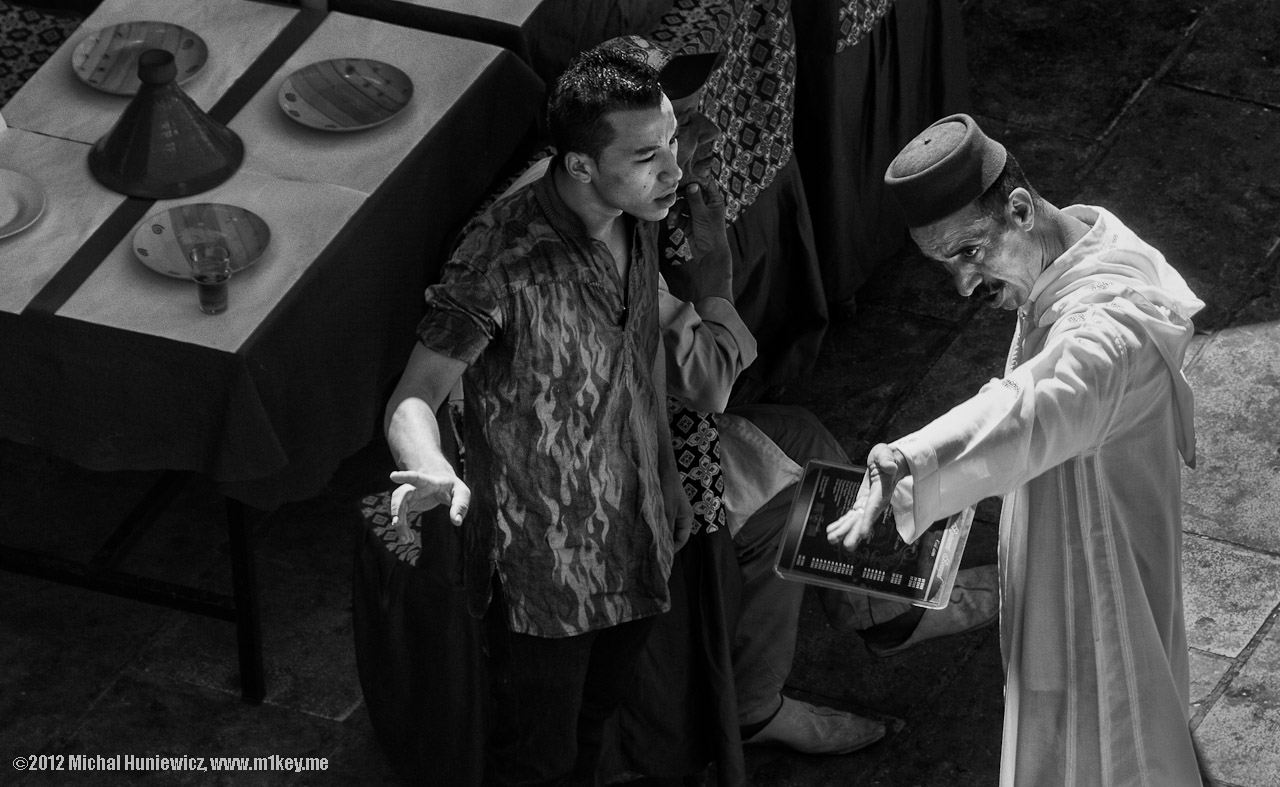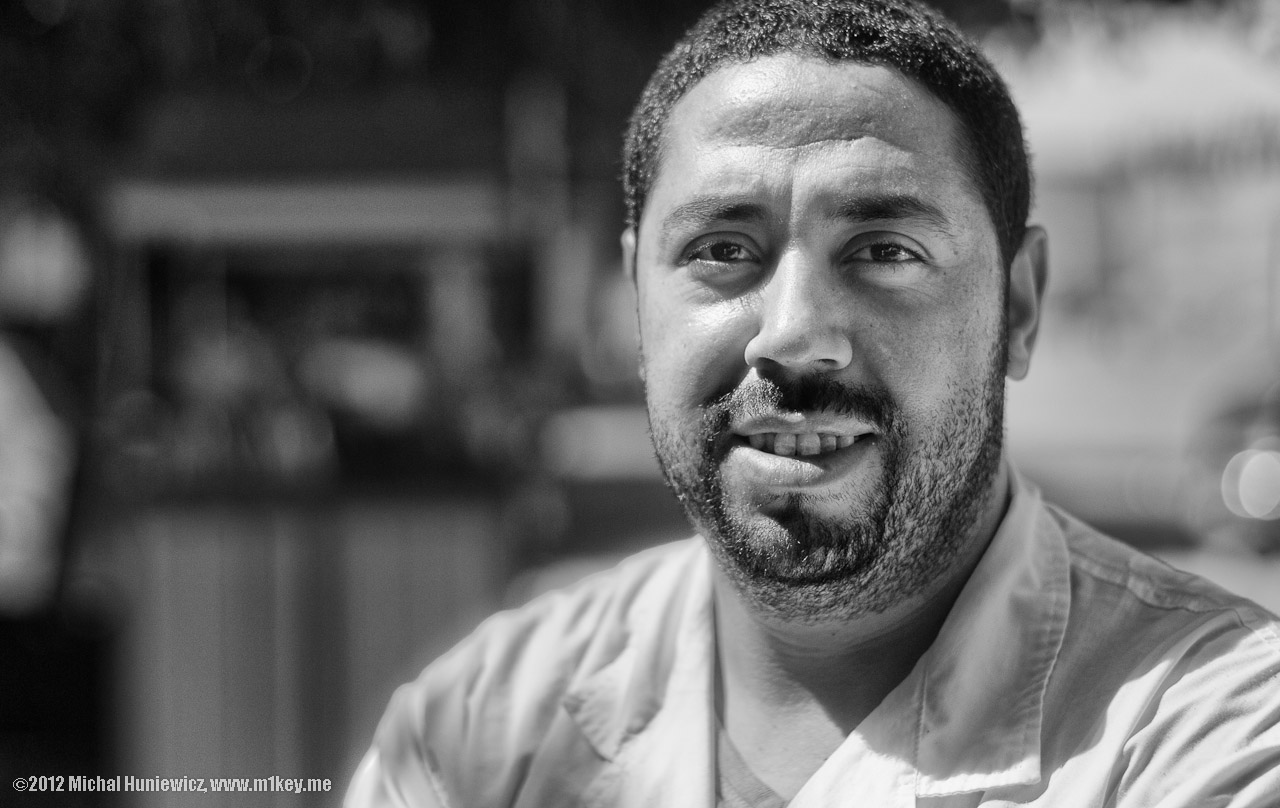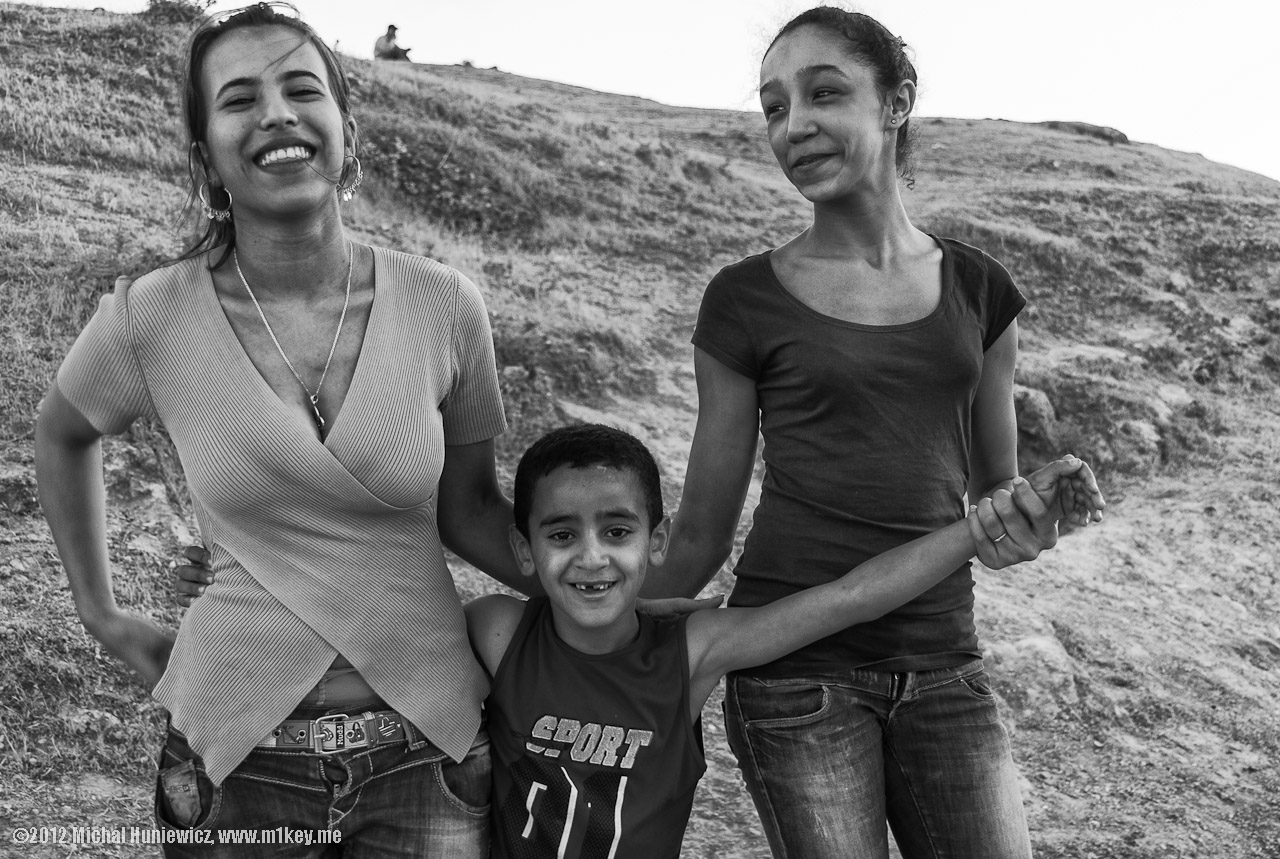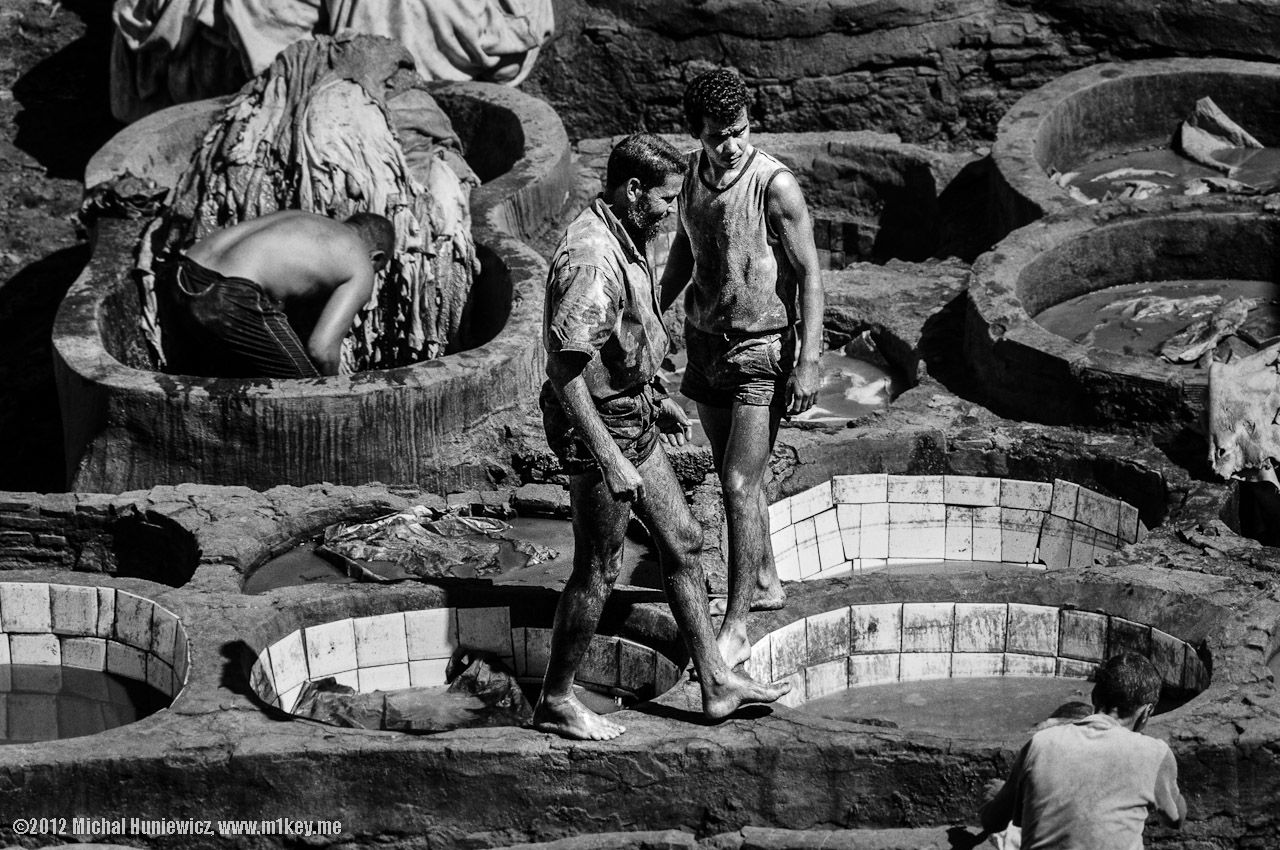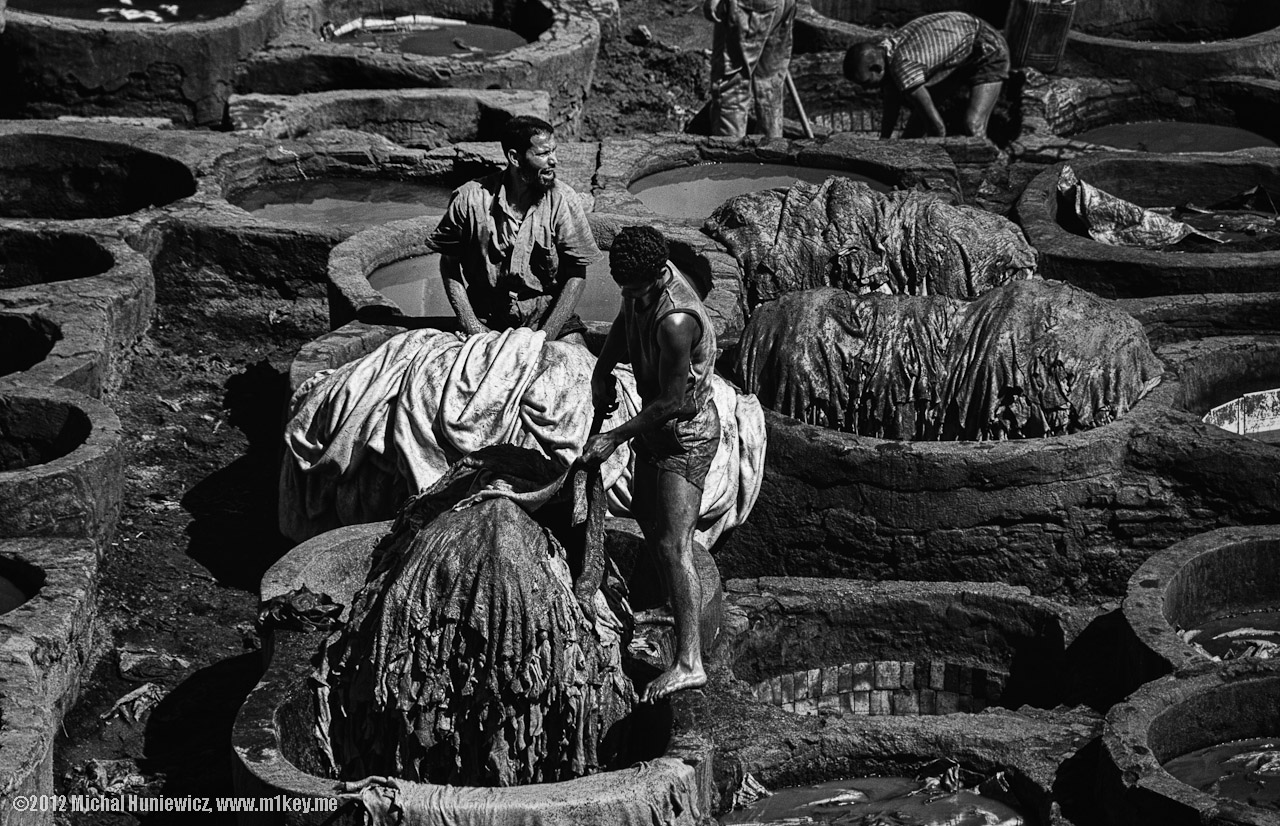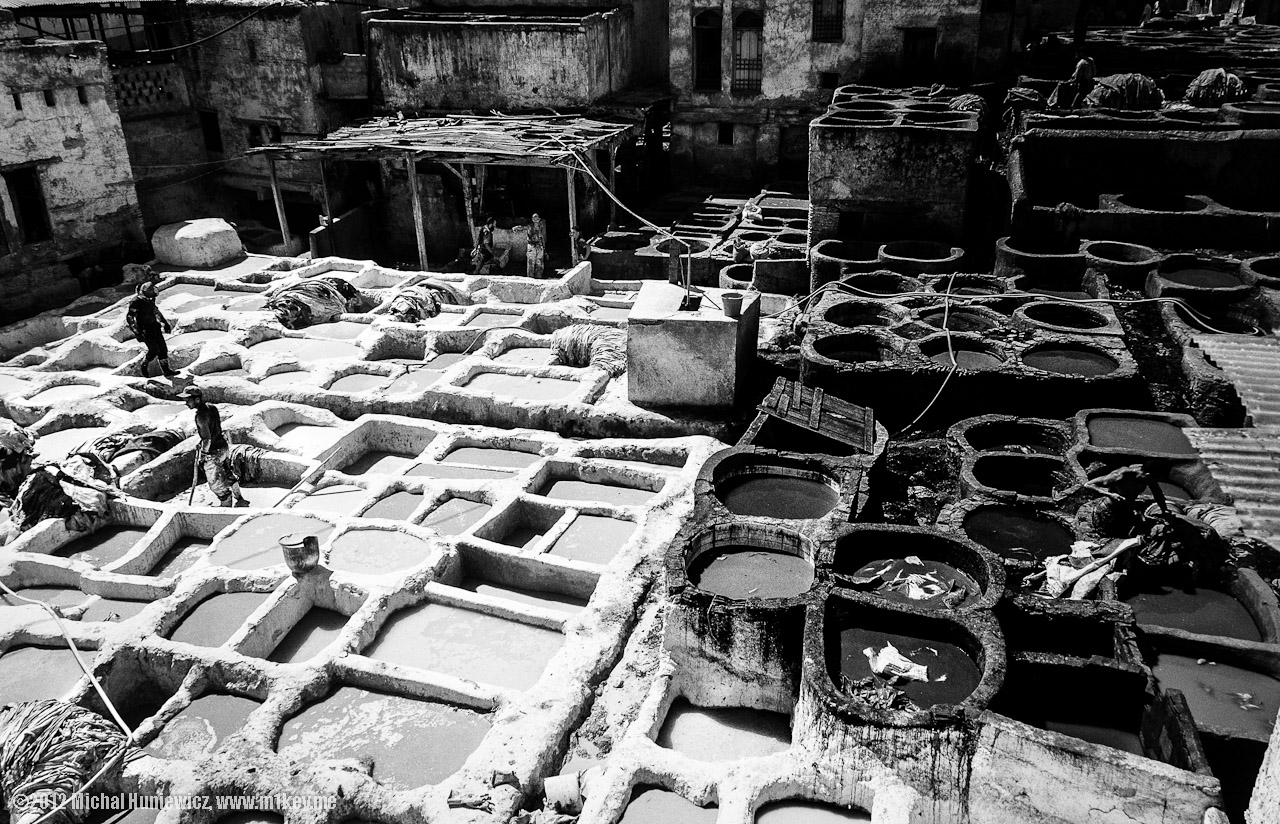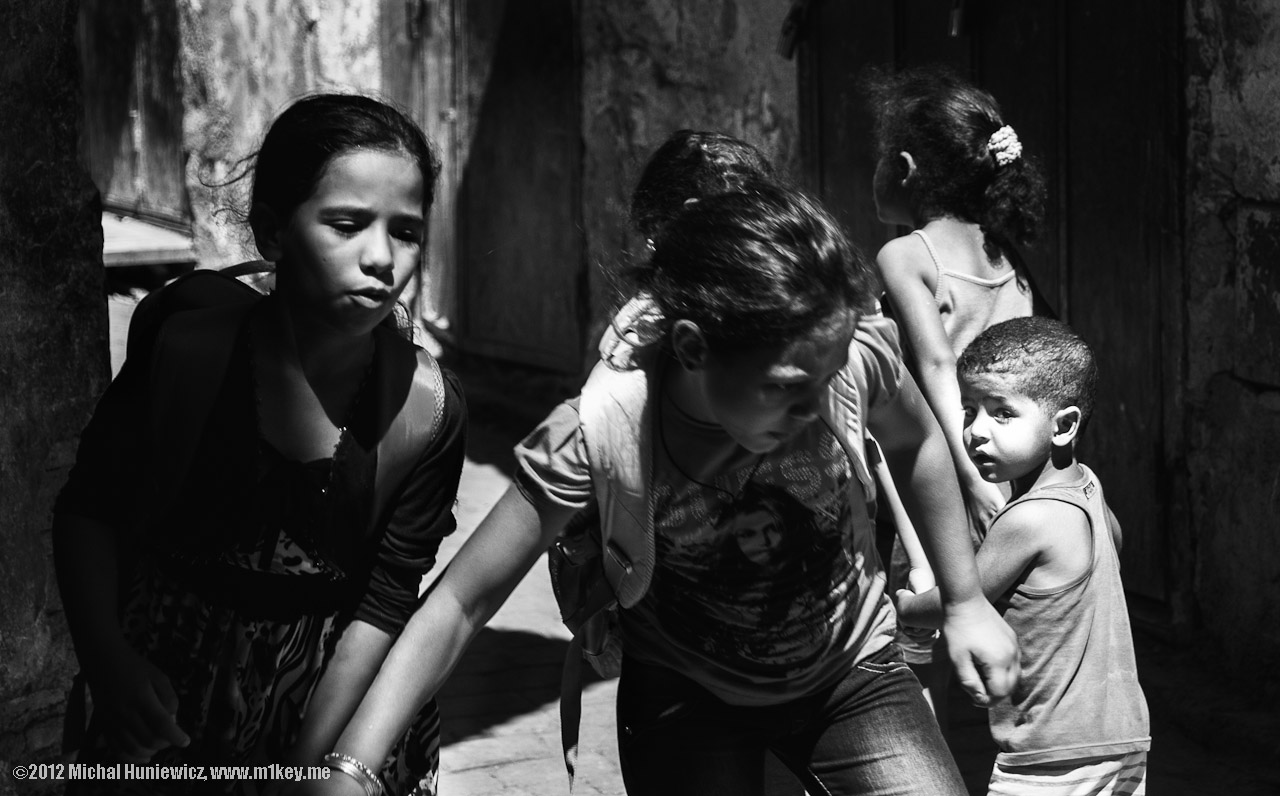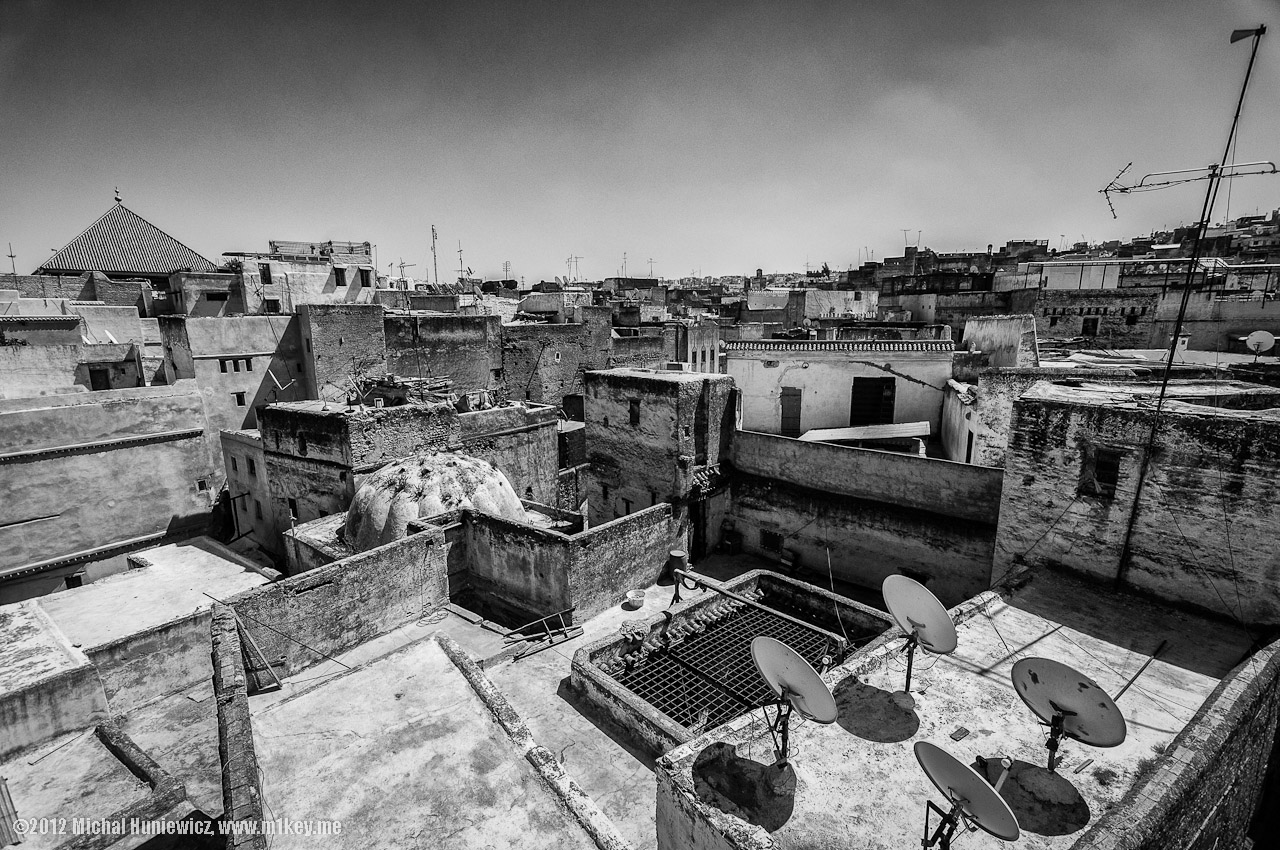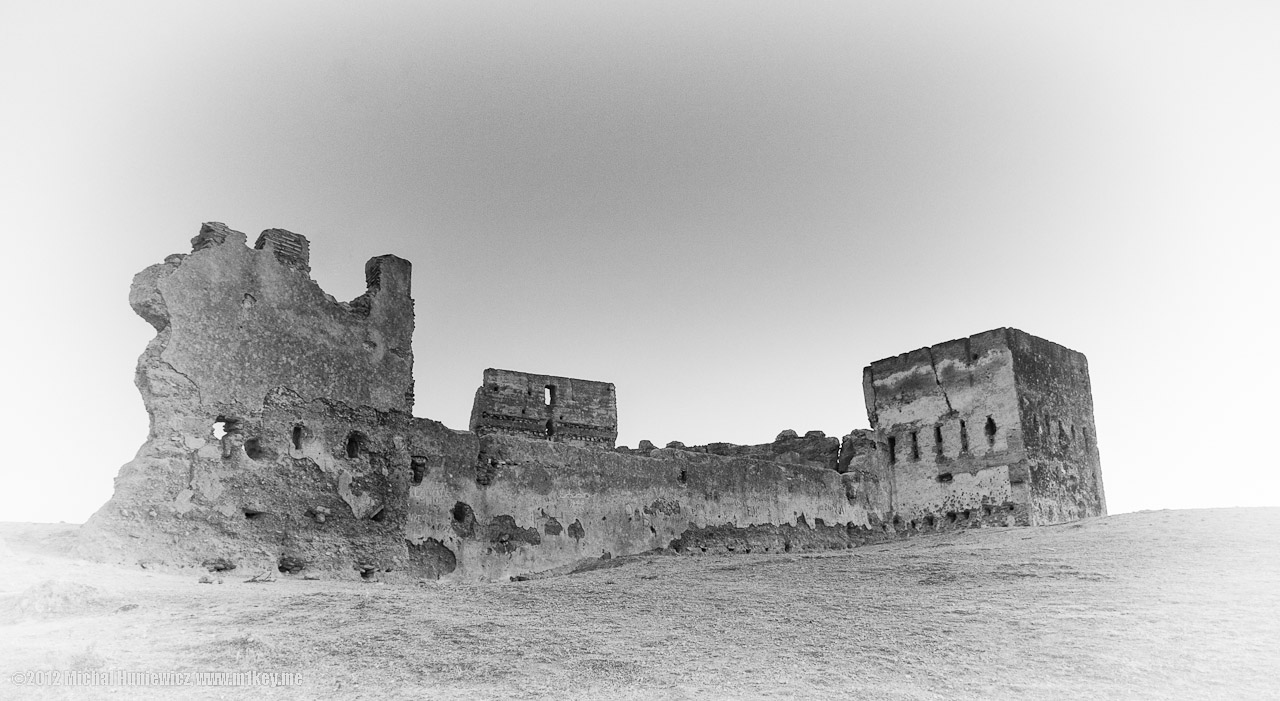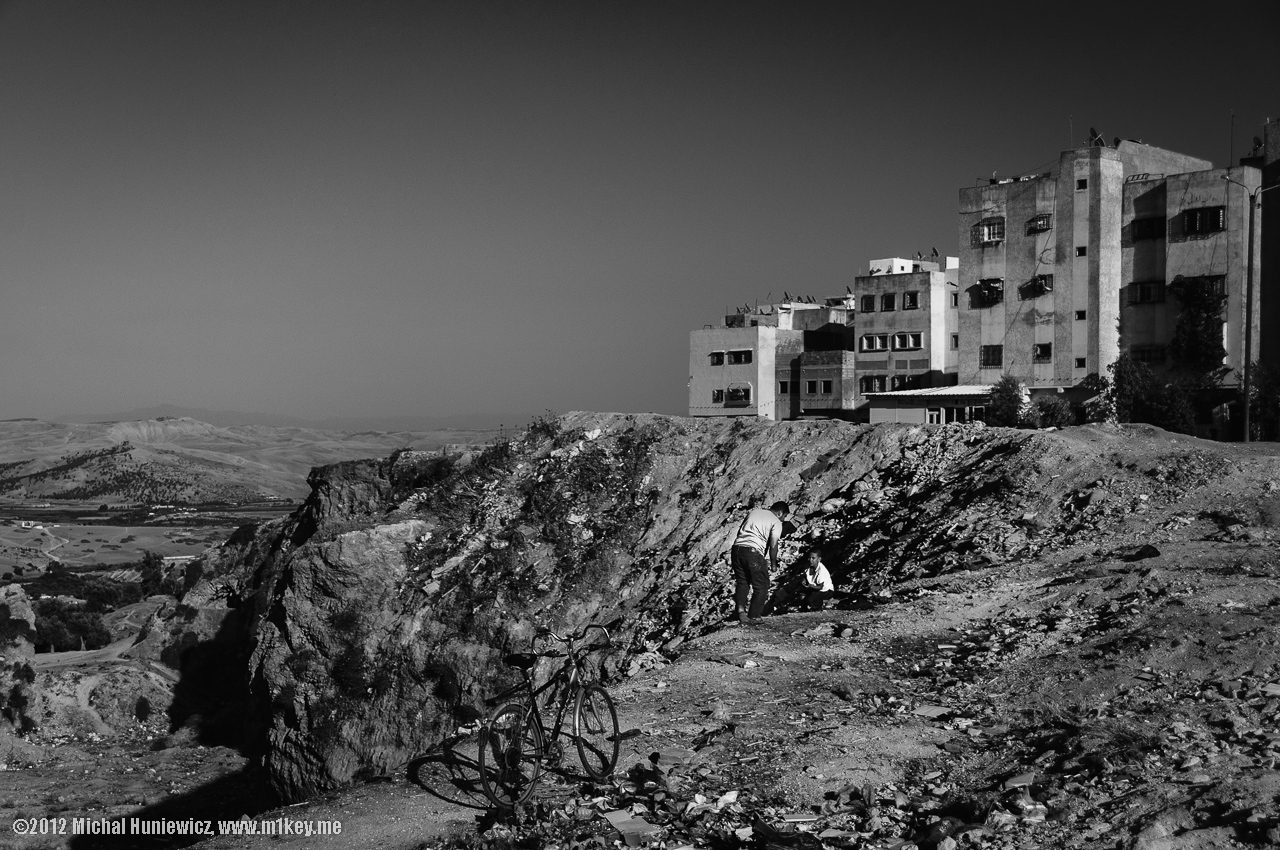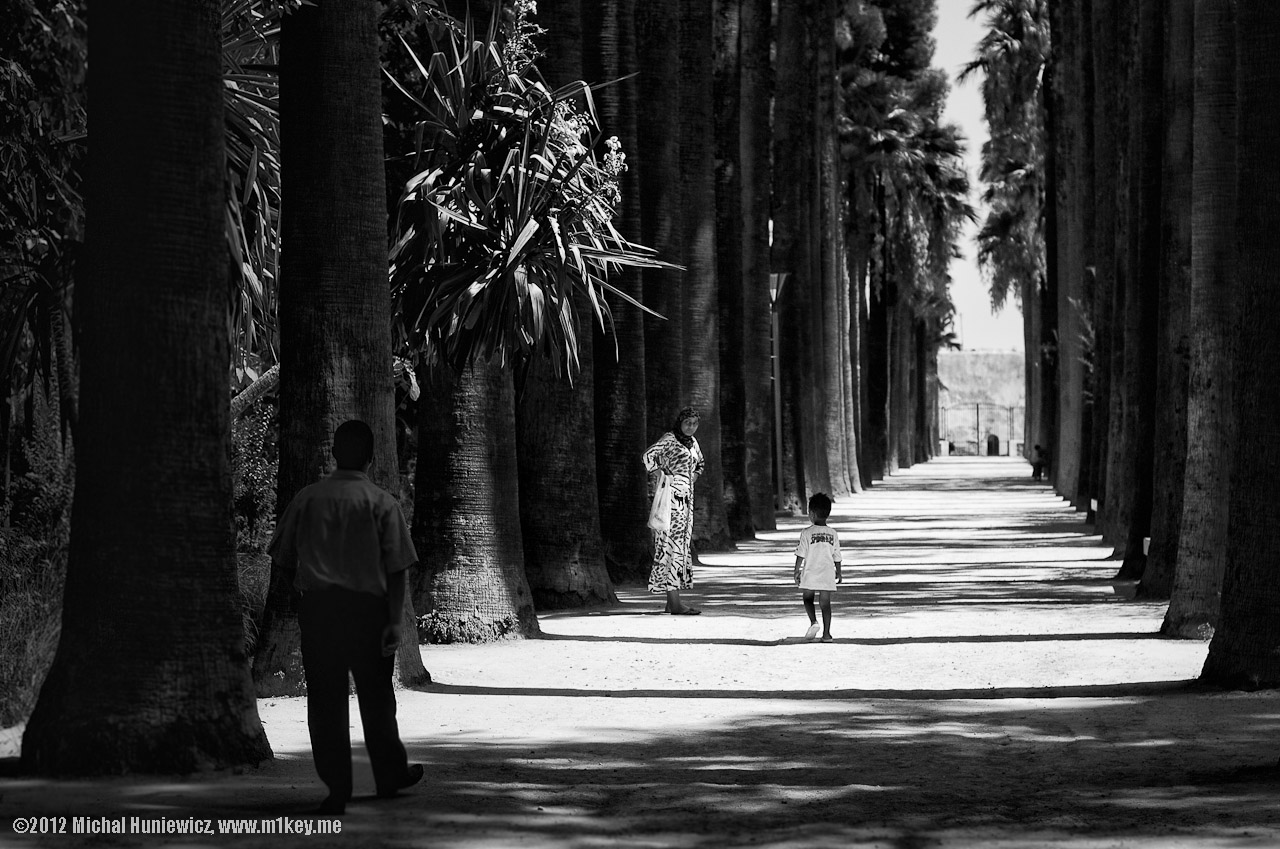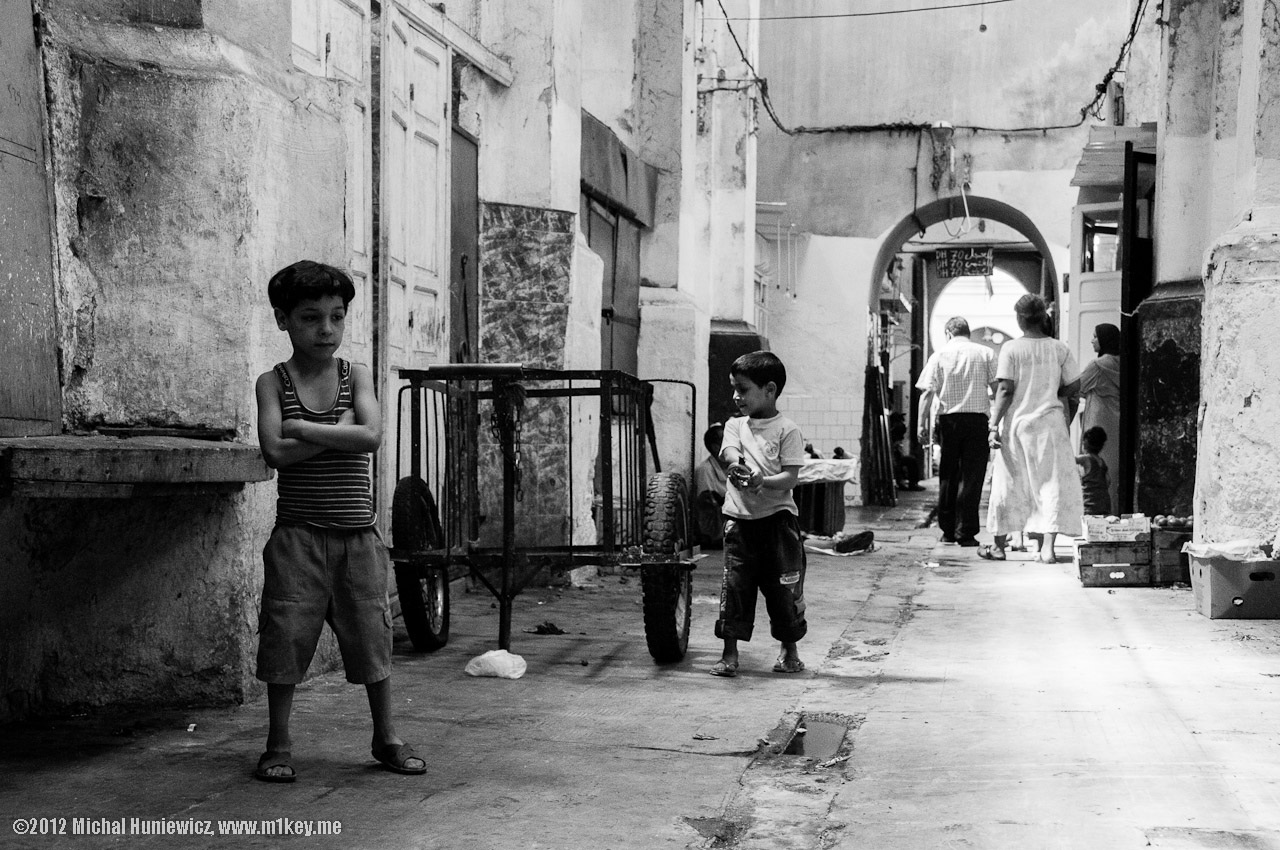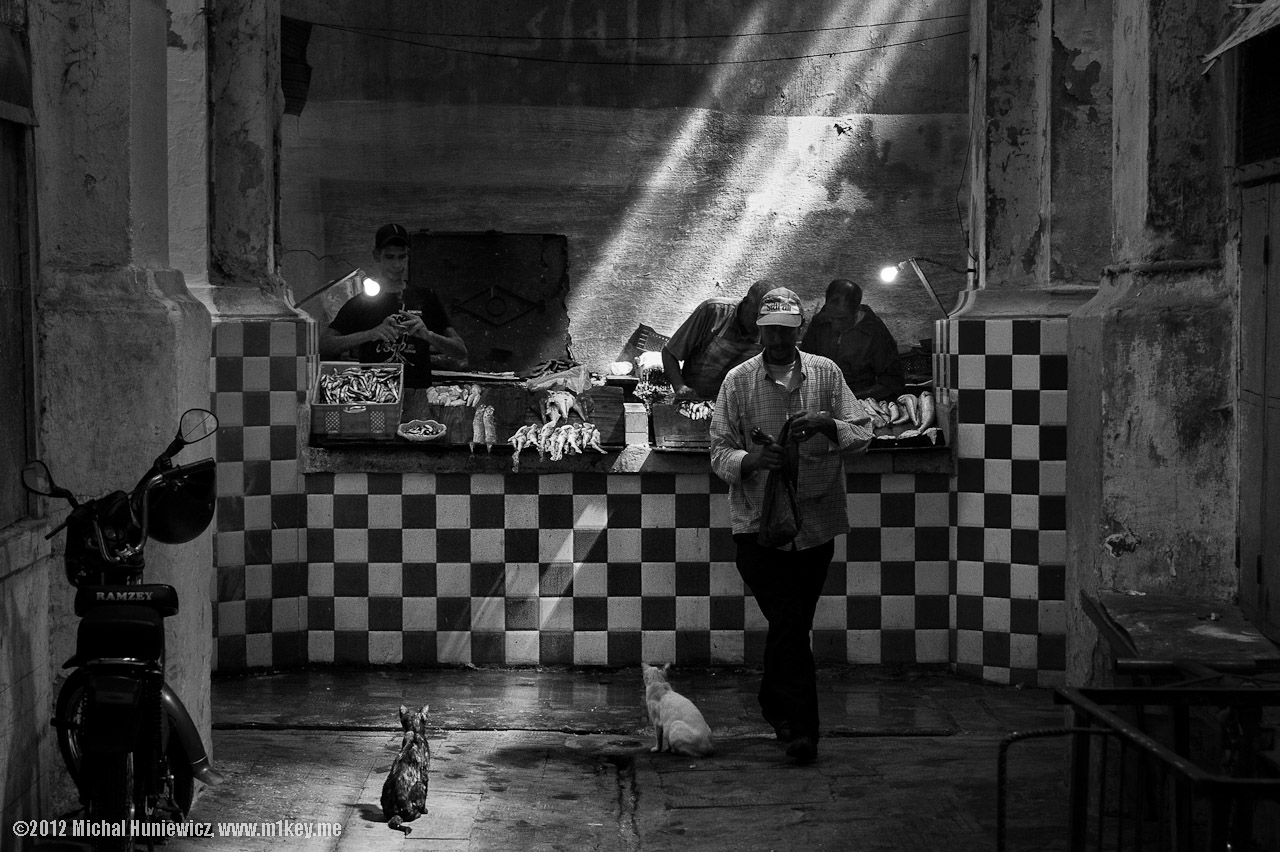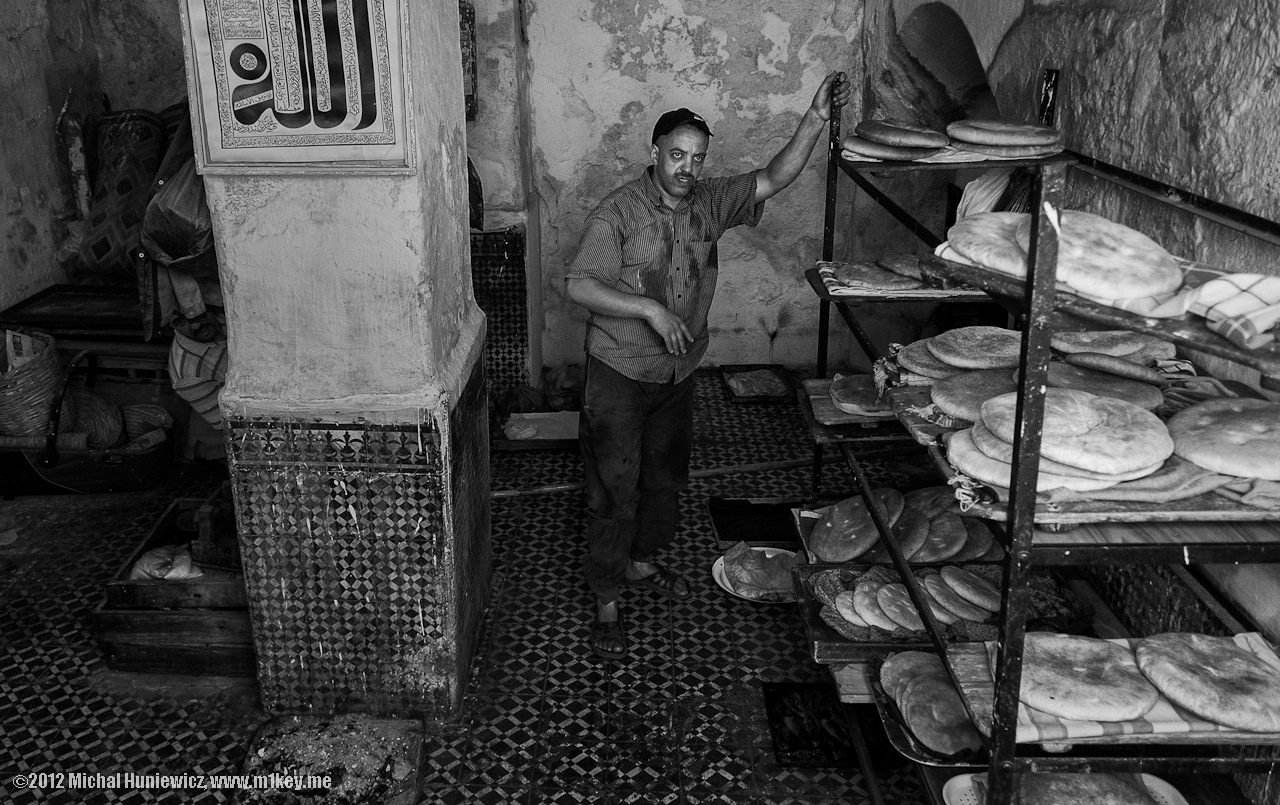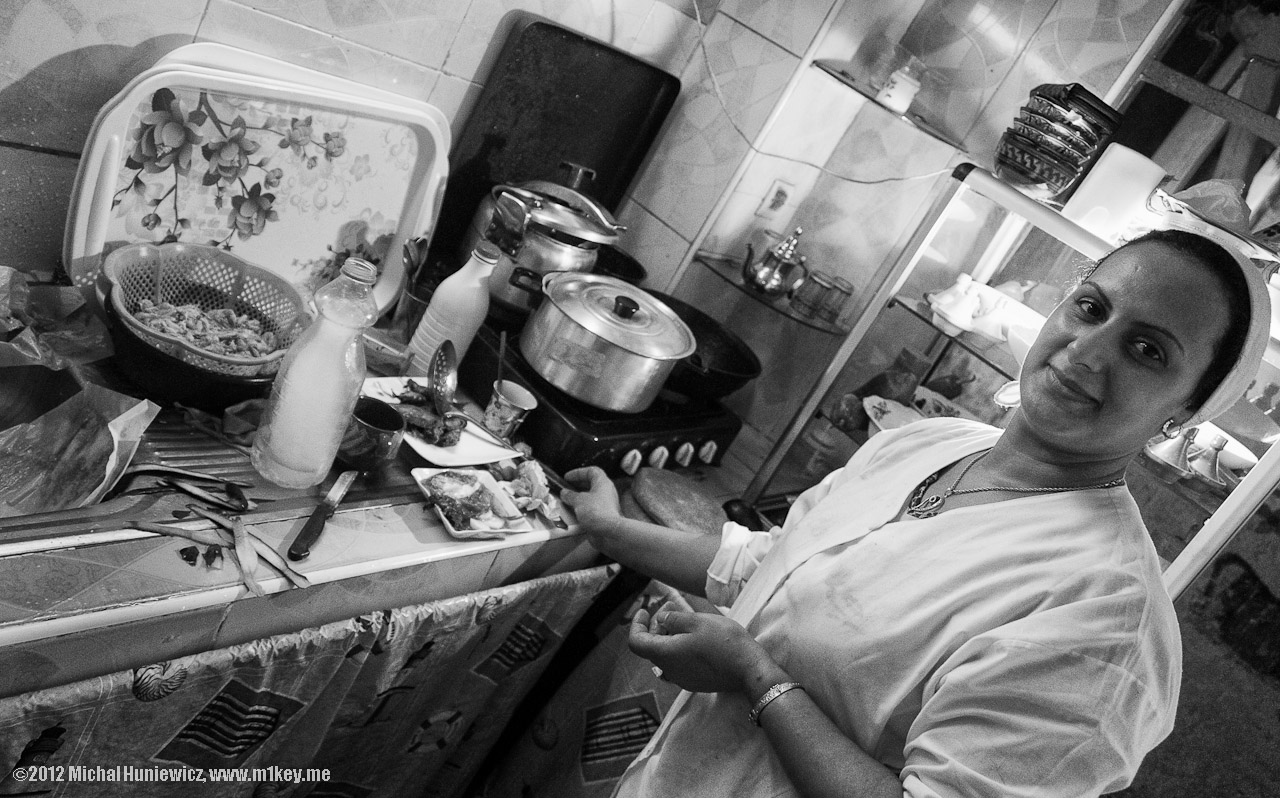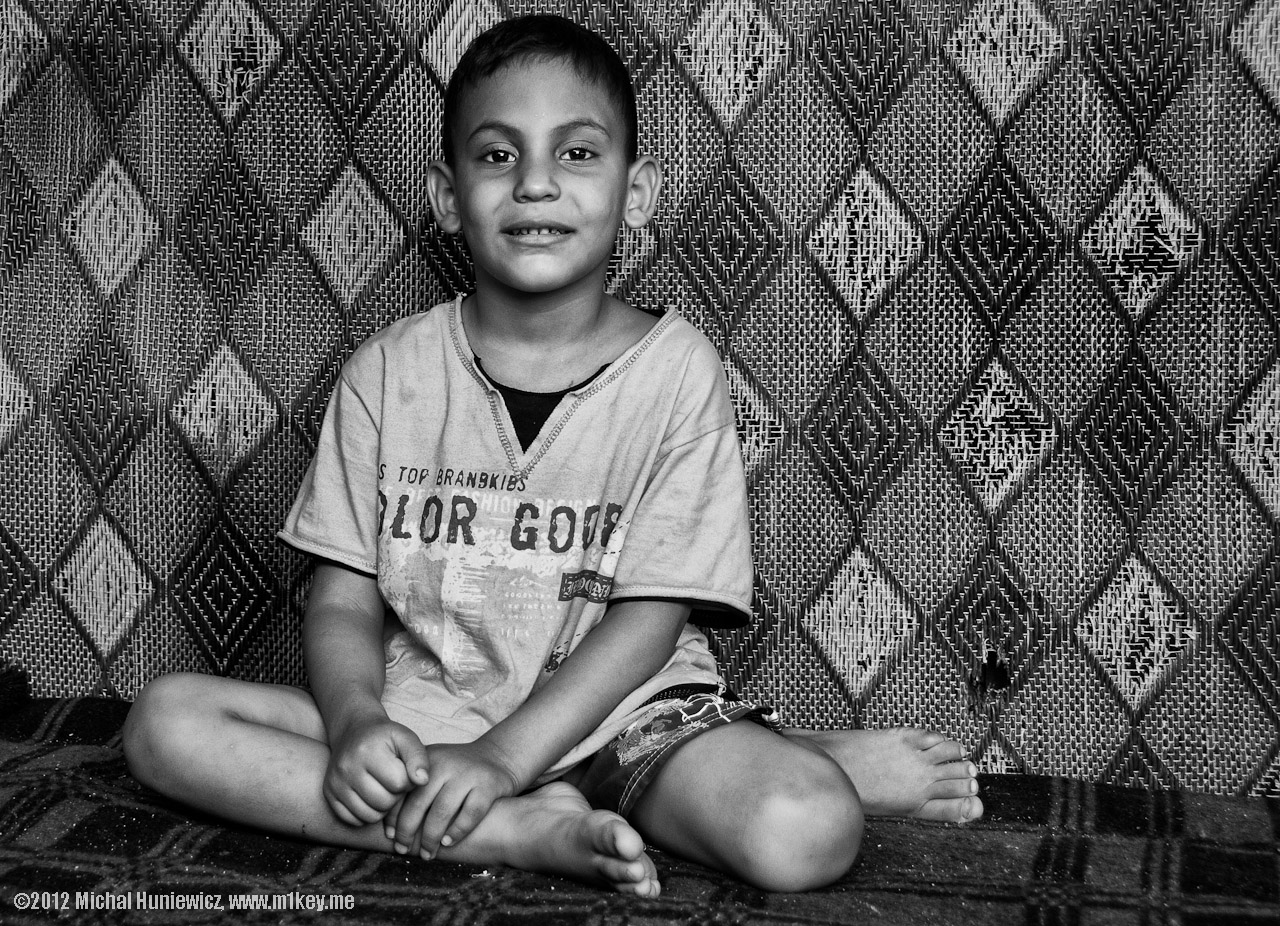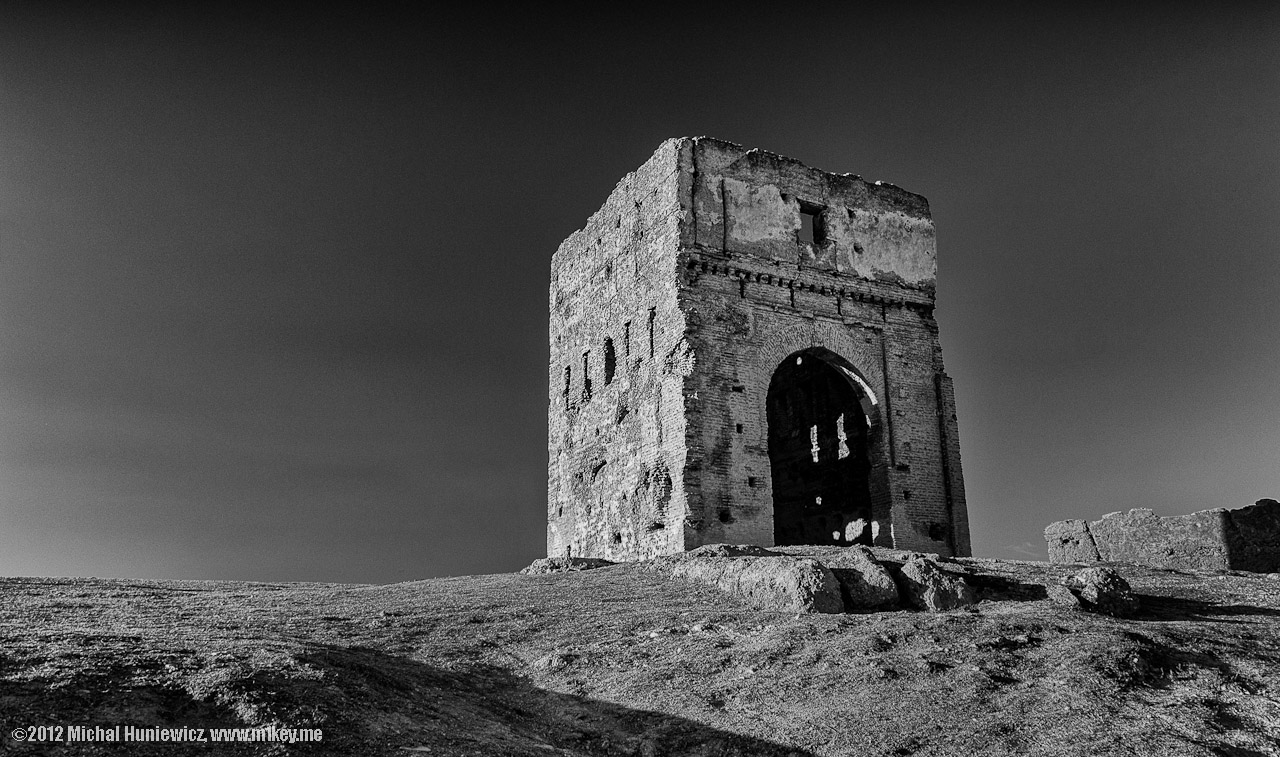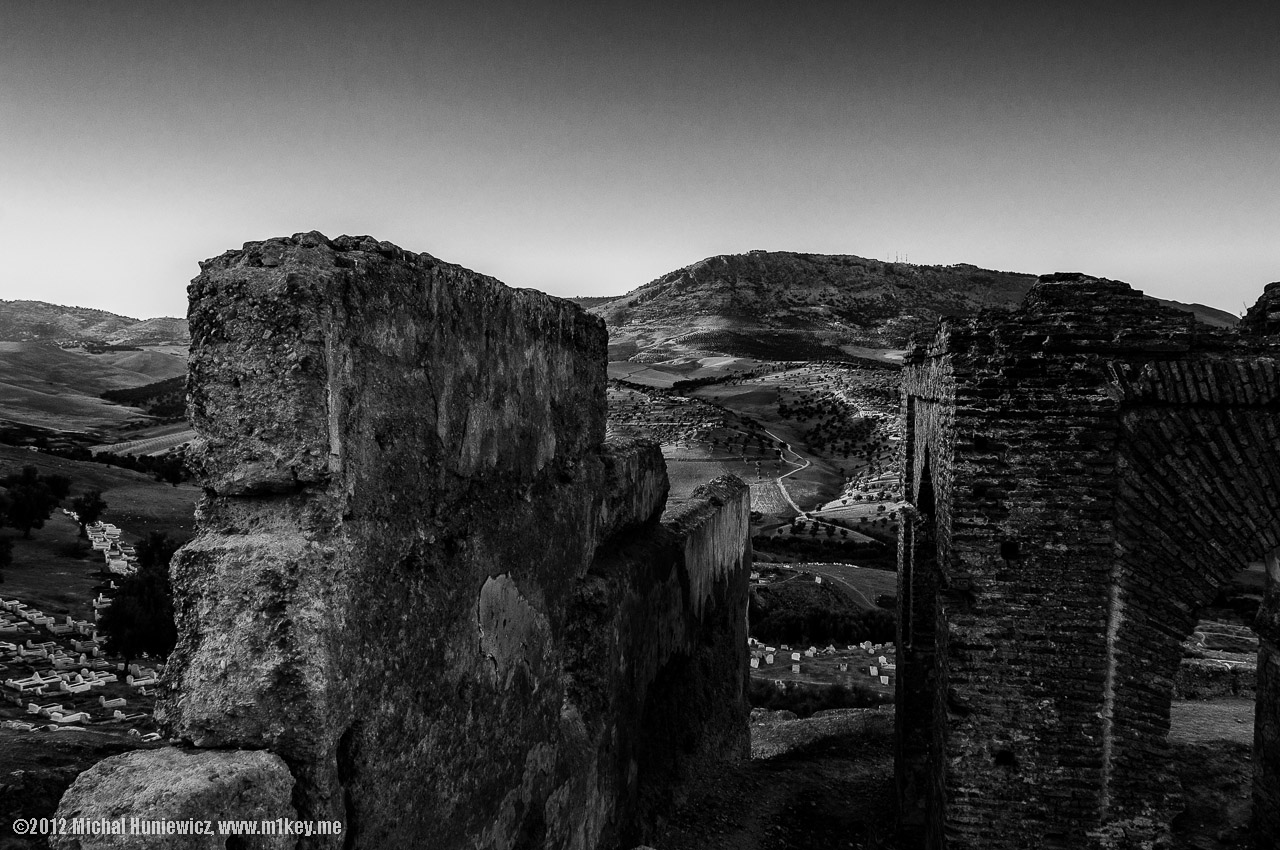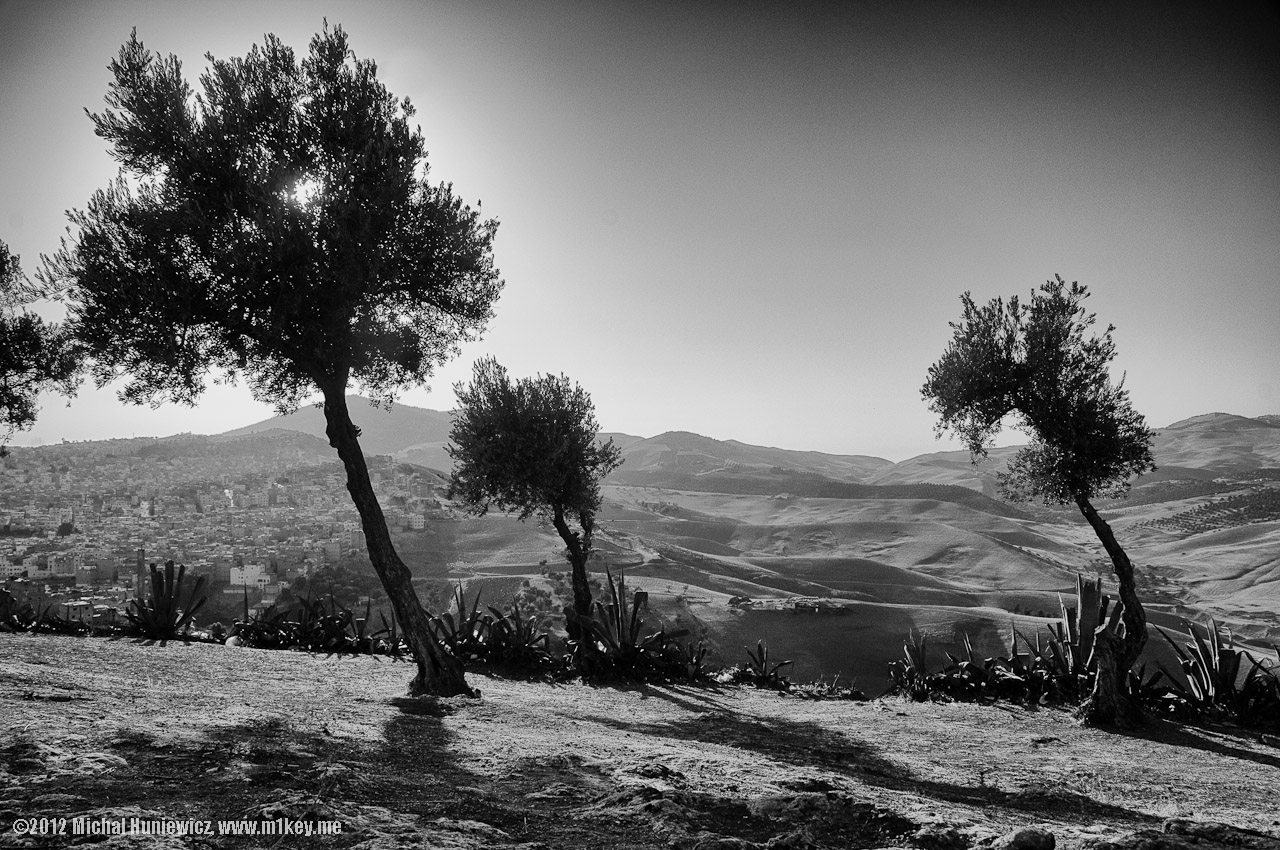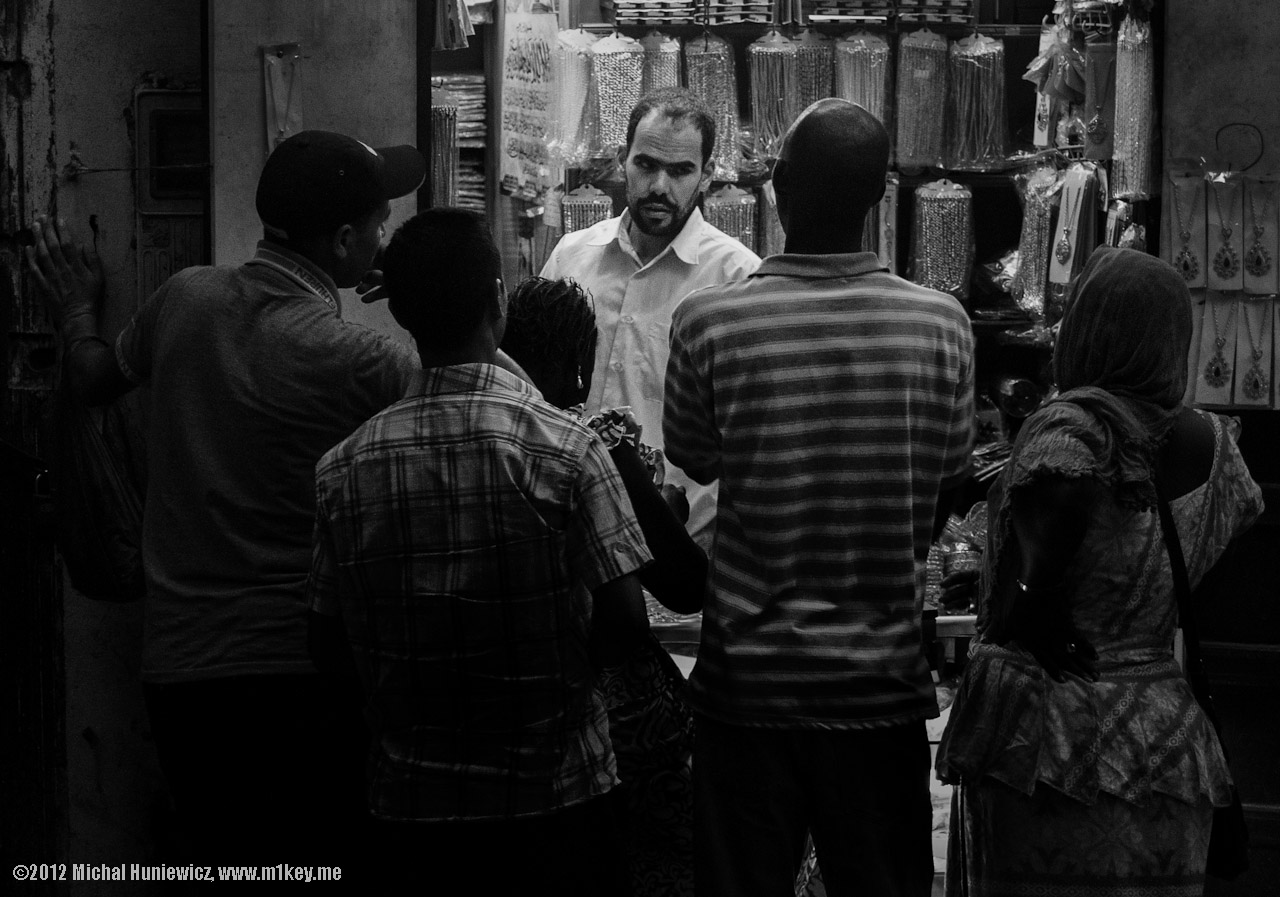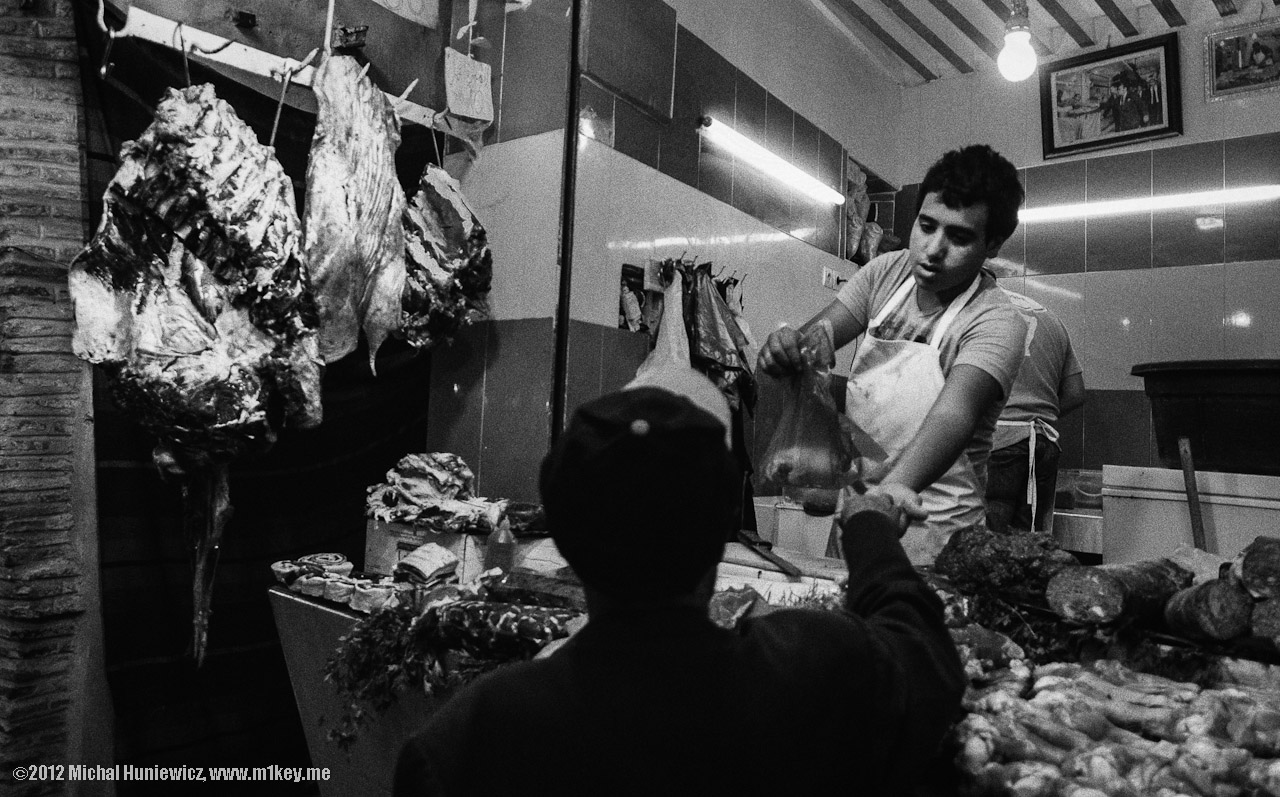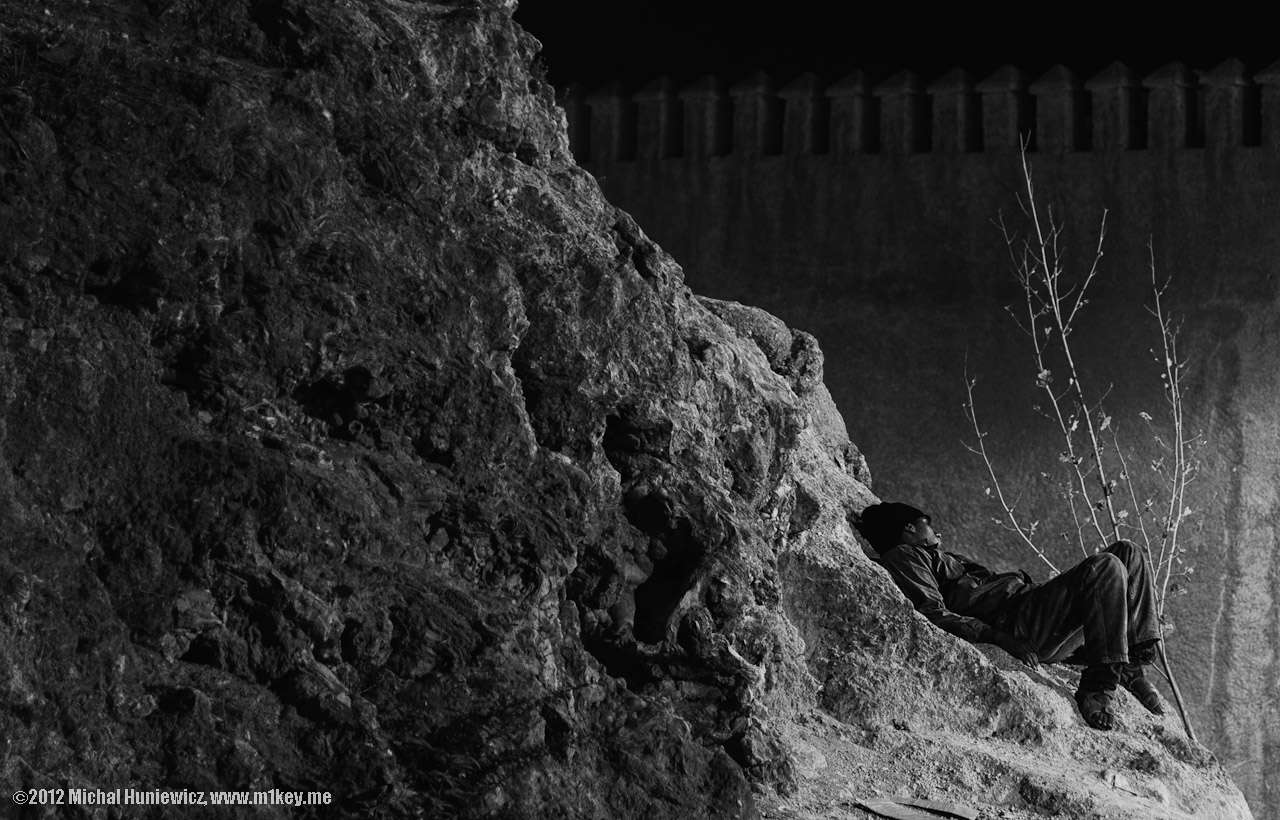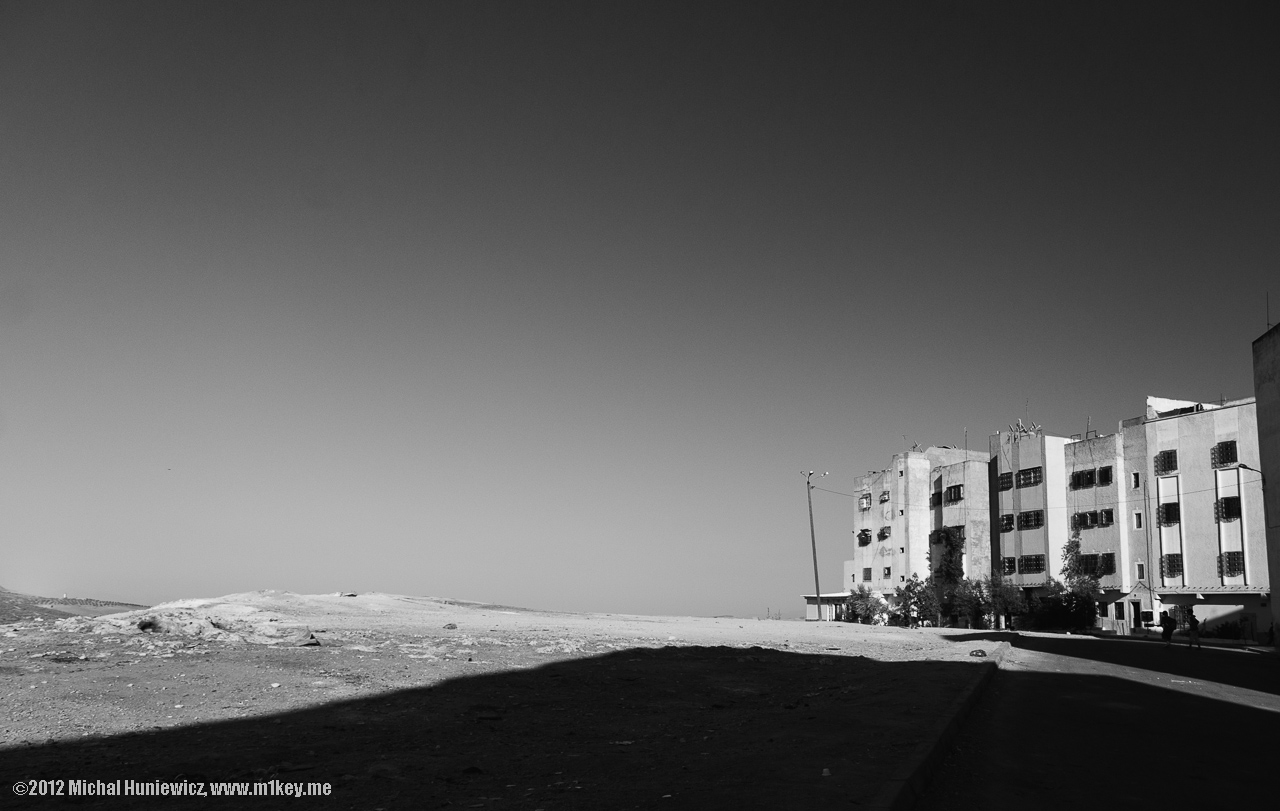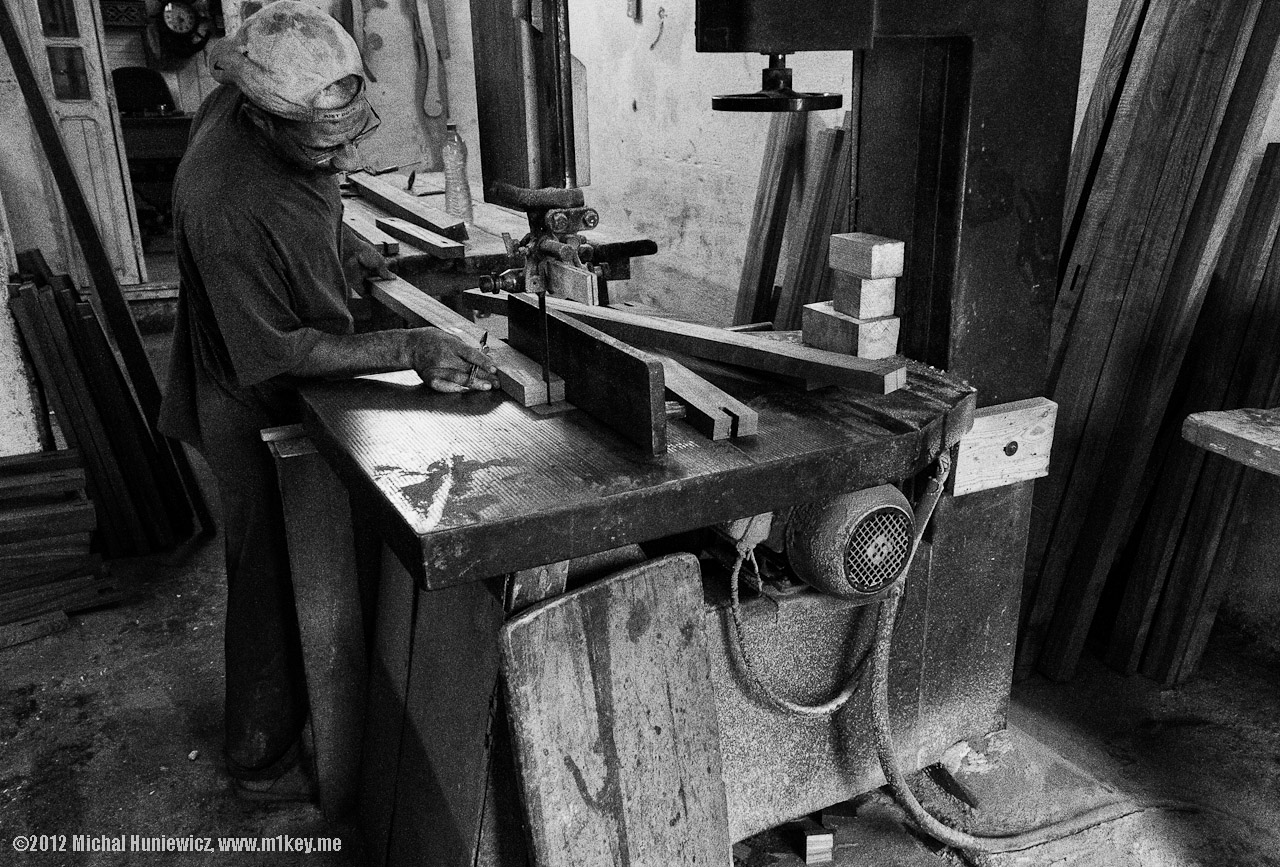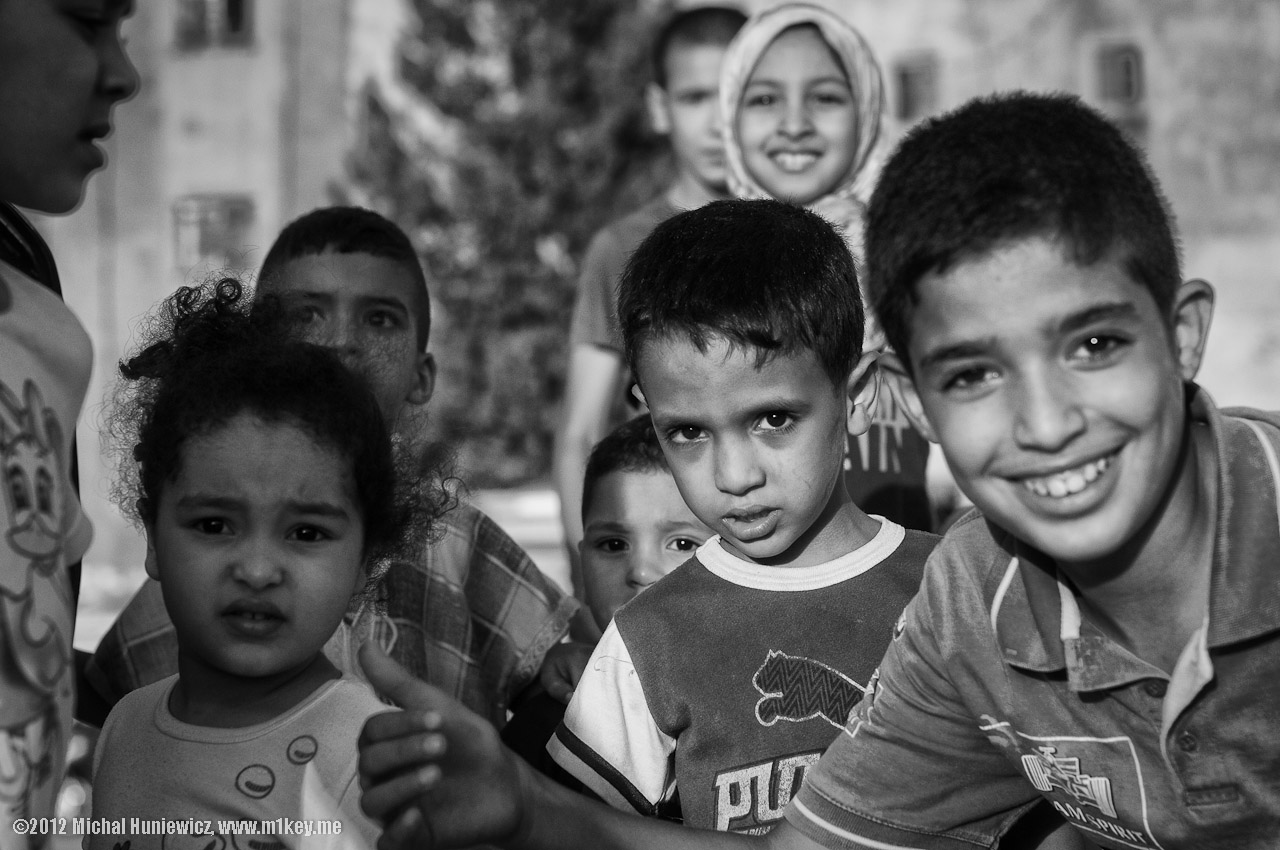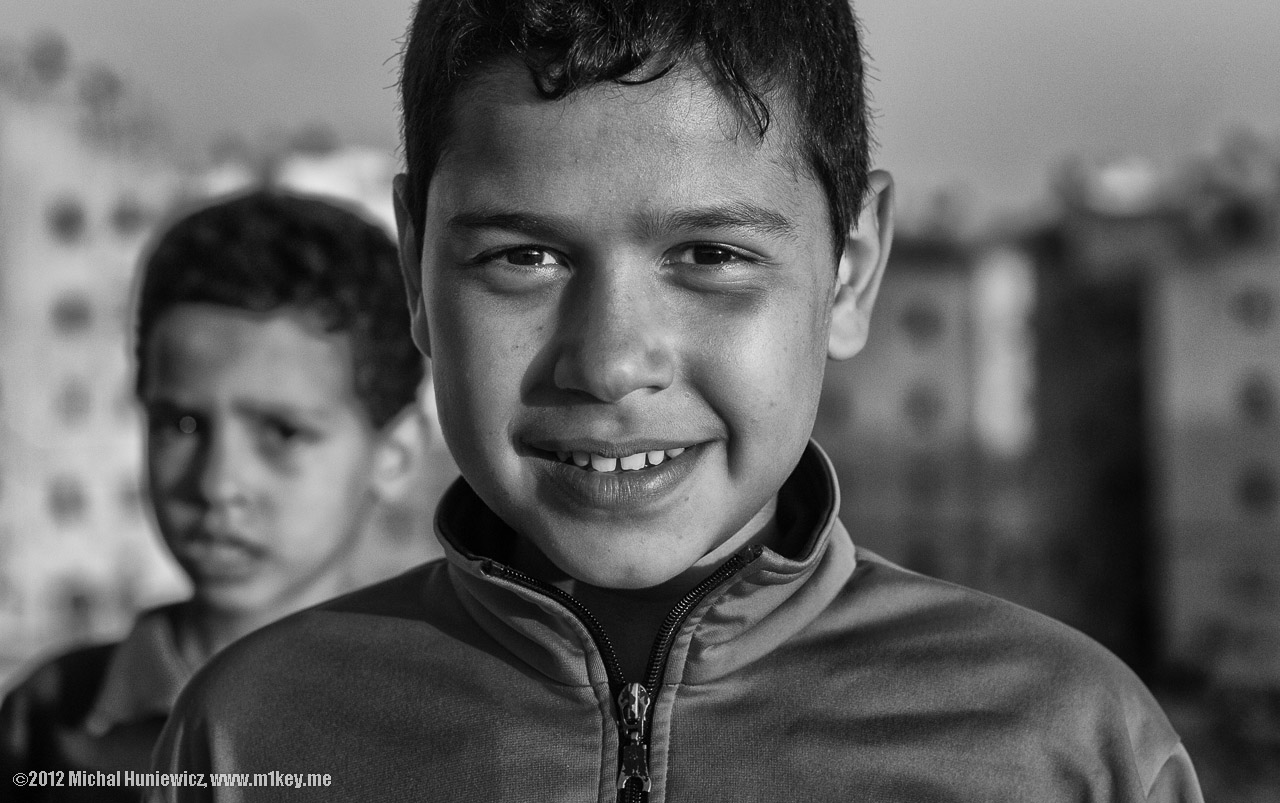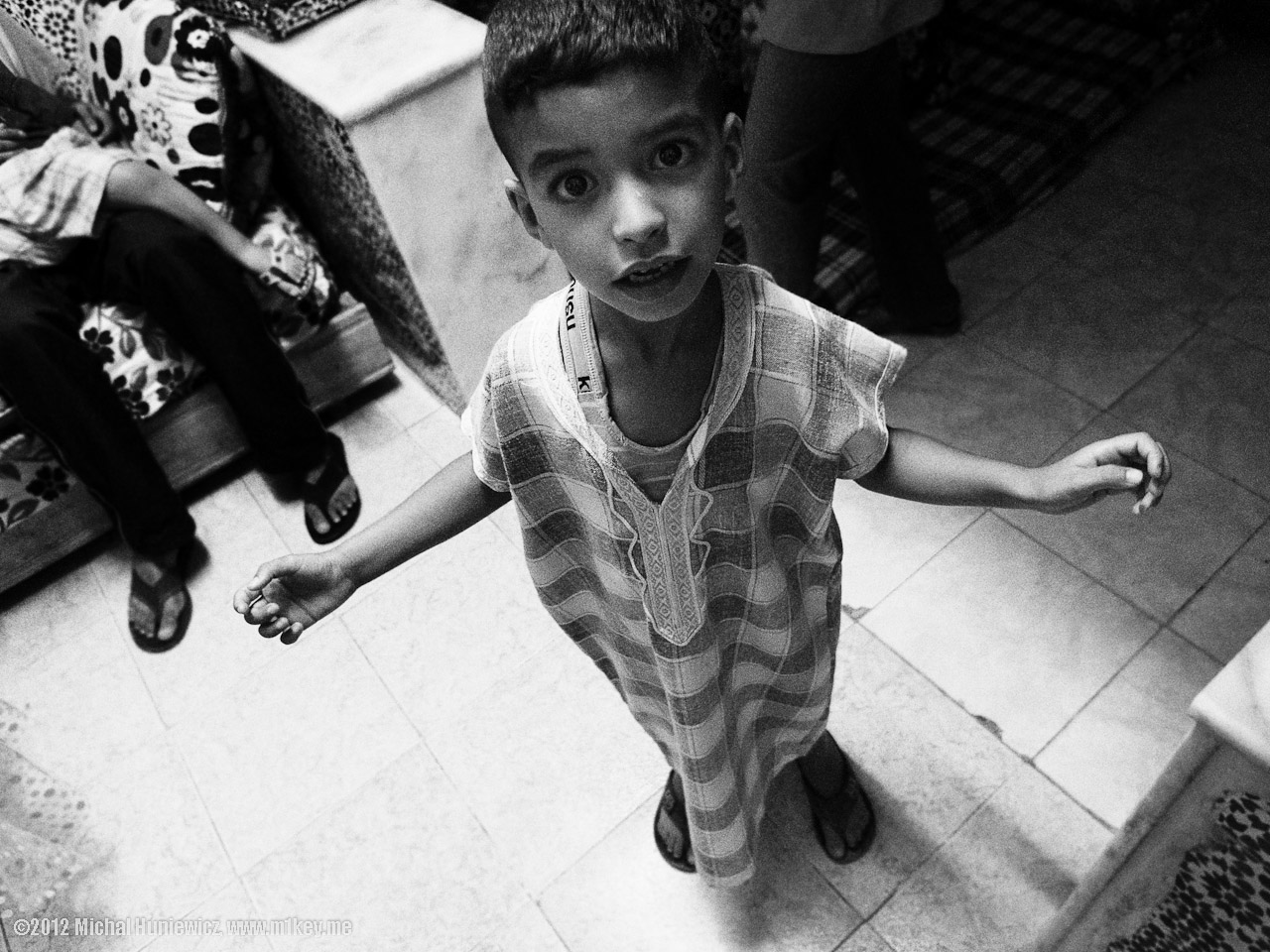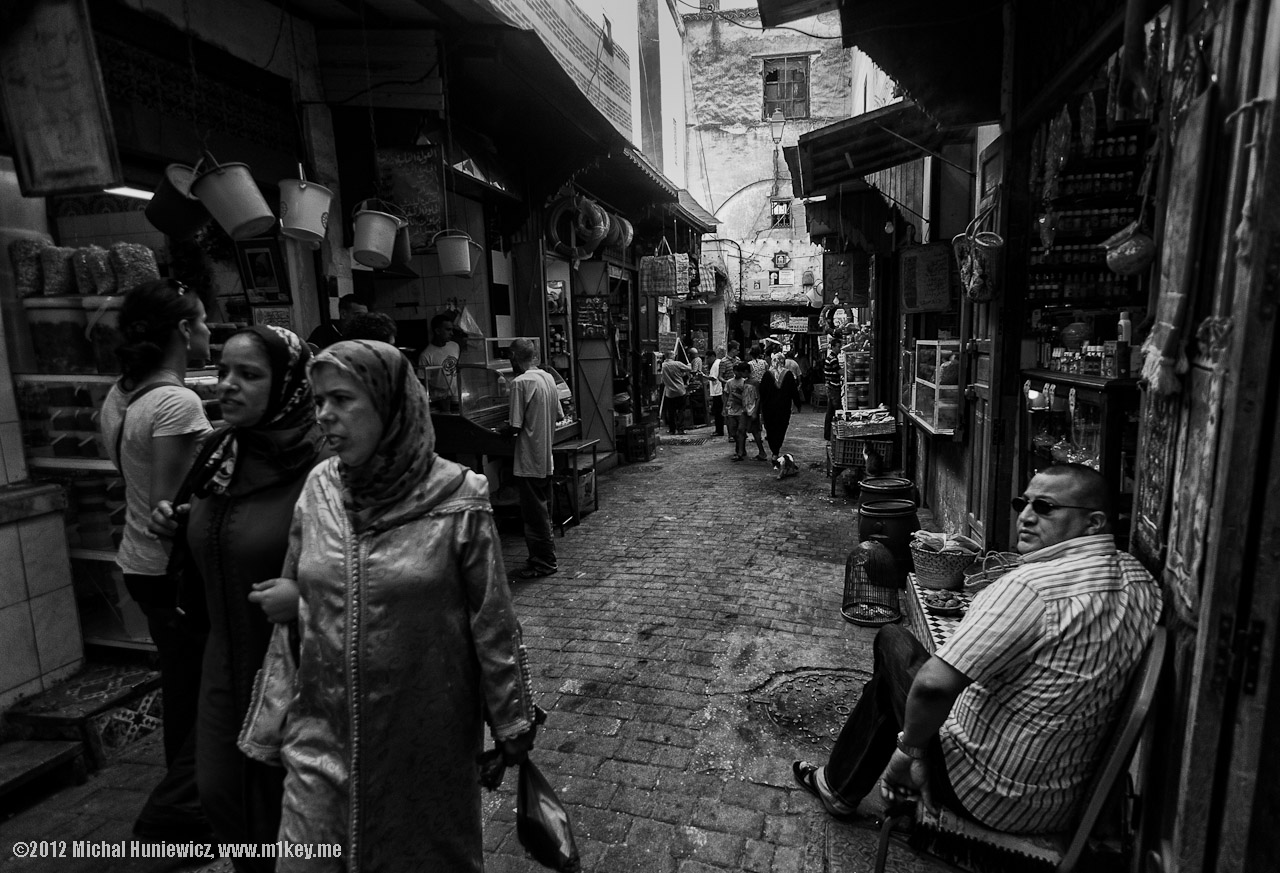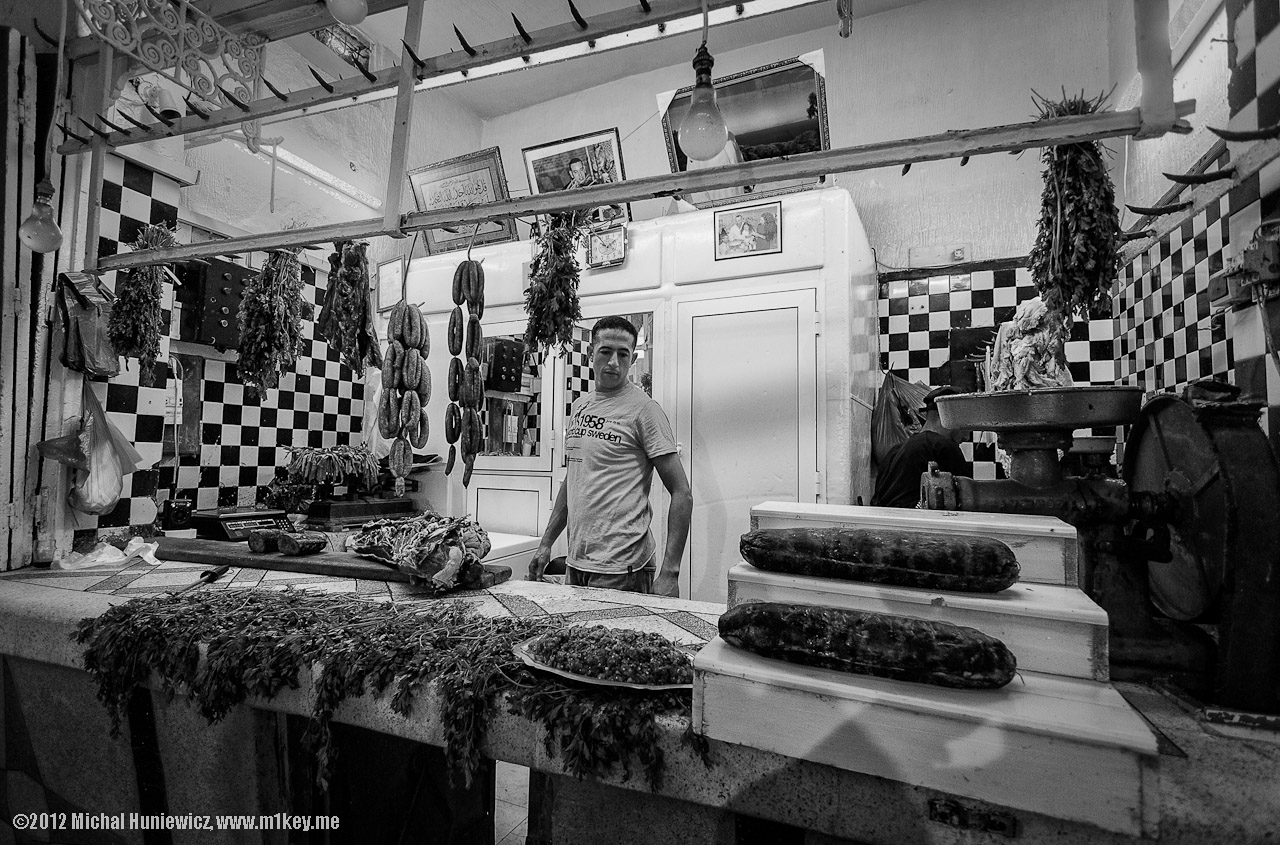Made in Medina Photography - M1key - Michal Huniewicz

Medina
Unlike many African countries, Morocco isn't a "new State" and it wasn't created by the colonialists, arbitrarily settling borders with a ruler;
its history goes way beyond that, [2, Preface] although it is hard to determine at which point in time Morocco was actually created and the national spirit emerged,
and the Moroccan borders are still disputed [3], which is a part of its colonial legacy.
In the picture, Fez medina from the Merenid Tombs hill.
ISO 100, 18mm, f/5.6, 1/100s.
Evening in Fez
People hanging out on the Merenid Tombs hill as the night approaches.
ISO 100, 18mm, f/3.5, 1/50s.
Police
Morocco feels rather safe. As in every other Muslim country I've been too, you feel like everyone wants to rip you off and sell
you things you don't need for much more than they are worth, but not rob you otherwise. We were, however, advised to leave the hill
area before 11PM.
In case you are wondering, the strange creature on the right, with four arms, is a man holding his jacket.
ISO 100, 18mm, f/8.0, 1/200s.
Tomb
These tombs apparently used to be colourful.
ISO 100, 18mm, f/5.6, 1/100s.
Ruins
Ruins on the hill.
ISO 100, 18mm, f/8.0, 1/100s.
Boys
What will probably surprise you in Muslim countries (at least those I have visited), if you come from a different cultural background,
is how young men interact with one another. They are a lot more intimate with each other than you might expect them to be; a lot more intimate
than straight men in Western countries. There is a lot of hand holding, general touching, and so on going on - but it is not considered gay in their culture.
In fact, they are not at all tolerant towards homosexuals. Their own behaviour however does not come across as homosexual to them, but it certainly does
to Westerners who see them holding hands, dancing together etc.
Most people I talked about this to, including people coming from that culture, suggested that this is how sexual oppression manifests itself;
that this is a way of dealing with sexual tension in a highly conservative society where you cannot easily and freely have sex before getting married.
ISO 100, 32mm, f/8.0, 1/100s.
Dusk
"Then the dead man would be carried to the cemetery, laid on his right side looking towards Mecca, and the shroud would be untied,
that there may be no awkwardness or delay upon the day of the Resurrection. And the Kadi or f'K'hay would say, 'O Allah, if he did good,
over-estimate his goodness; and if he did evil, forget his evil deeds; and of Thy Mercy grant that he may experience Thine Acceptance;
and spare him the trials and troubles of the grave...'" [4, ch. IX]
ISO 100, 18mm, f/8.0, 1/100s.
Trees
Sun going down over Fez.
ISO 200, 18mm, f/10.0, 1/250s.
Scooter
Morocco is westernised to some extent, and it's been tied to the western block for a while now, through various military
and economic deals. [2, p. 174-175] It even tried to join the EU, but its application was rejected, as it's not a European country,
but that, still, resulted in reduced restraints on trade.
Today, Morocco has strong economic ties with Europe and is the first country in the region to be granted advanced status. [14]
ISO 100, 56mm, f/4.8, 1/100s.
Tombs
When, in 1979, the Iranian revolution began, Moroccan King Hassan wasn't going to fall like the Shah. He fought the
Islamists and reminded them that it was he who was the Commander of the Faithful. The Islamists didn't have anyone
quite as charismatic as Khomeini, and the movement was never united. Islamic revolution in Morocco failed. [2, p. 176]
ISO 200, 170mm, f/5.6, 1/500s.
Underworld
Old man stepping out of the "underworld of the souks. [T]heir looks look is uniformly melancholy. [...]
The farther west she extends, the more she becomes self-contained, sombre, uninfluenced, a gloomy fanatic with
her back to the walls of the Atlantic and the Atlas. [...] This ashen crowd swarming gloomily through the dark tunnels
represents the real Moghreb that is close to the wild tribes of the 'hinterland' and the grim feudal fortresses
of the Atlas. How close, one has only to go out to Sefrou on a market-day to see." [5, p. 47]
ISO 200, 18mm, f/3.5, 1/40s.
Madrasa
Ibn Battutah, the great Moroccan traveller of the 14th century, very often stayed for a few days in different madrasas,
like this one [8, p. 49], or maybe even this one [8, p. XX, 295]. This was one of the benefits of the Islamic Empire; common language, and you were welcome to stay in such colleges,
where you'd be fed food and knowledge.
ISO 200, 18mm, f/3.5, 1/80s.
Wall
"We who live within the city walls must hasten now, for the time of gate-closing is upon us, and one may not stay outside. [...]" [4, ch. VII]
I asked one of the locals about the holes in those walls. "It's for the birds!", he replied without much hesitation. That's, of course, not true;
in reality those walls were made of concrete, which in turn was made from rocky earth and lime, the whole construction originally reinforced by pieces of wood
running horizontally, now gone, leaving those holes. [2, p. 57]
ISO 200, 36mm, f/4.2, 1/1000s.
Beggar
I got yelled at by a random person for photographing this photogenic blind man. In Fez you get yelled at a lot!
ISO 200, 50mm, f/4.0, 1/160s.
Yes to the constitution
The sign is from 2011 and says "Yes to the Constitution". In the referendum, 98% of people voted yes, indeed.
The revised constitution grants the government executive powers, but retains the king at the helm of the army, religious
authorities, and the judiciary, and still allows him to dissolve parliament, though not unilaterally as was the case. He is no longer
"sacred" either. Women were granted more rights, and Berber has become an official language. [13]
ISO 200, 46mm, f/4.5, 1/200s.
Foundouk el-Nejjarine
This foundouk used to provide shelter and food to traders. Today, it's the Museum of Wooden Arts and Crafts. [17]
ISO 200, 11mm, f/3.5, 1/40s.
Palm trees
"[...] There we caught our morning view of the forest of date-palm that girdles the town." [4, ch. V]
ISO 640, 22mm, f/3.8, 1s, IR filter, tripod.
Carpet shop
This place was restored thanks to UNESCO donations. Moroccans then turned it into a carpet store.
ISO 1800, 18mm, f/3.5, 1/30s.
Mosque
Fez at night - today. Fez at night - one hundred years ago:
"Nobody is in the streets wandering from ghostly passage to passage, one hears no step but that of the watchman with staff and lantern.
Presently there appears, far off, a light like a low-flying firefly, as it comes nearer, it is seen to proceed from the Mellah lamp of
open-work brass that a servant carries ahead of two merchants on their way home from Elbali." [5, p. 51]
ISO 200, 50mm, f/4.8, 1.3s, tripod.
Jewellery shop
Jewellery shop in the souk.
ISO 2000, 55mm, f/4.8, 1/30s.
Selling meat
Selling meat in the souk.
ISO 320, 16mm, f/2.8, 1/50s.
He's not a princess
Sleeping on the rocks.
ISO 100, 112mm, f/5.3, 4.0s, tripod.
Argument
Moroccans arguing about customers. There's a lot to fight for, as tourism accounts for approximately 10% of Morocco's GDP [7].
On the table, see a tajine pot - tajine is a traditional Berber dish. [15]
While hanging out in Fez, we met a young man called Rachid. Here's a conversation I had with him.
Me: What do you do, do you have a job?
Rachid: No, I don't have a job. I have education but no job.
Me: Why not?
Rachid: It's the government, they don't do anything.
Me: What is the ruling party?
Rachid: The Islamic party.
Me: Who did you vote for?
Rachid: The Islamic party.
Me: What other parties are there?
Rachid: I don't know.
ISO 200, 150mm, f/7.1, 1/125s.
OJ
This is Muhammad Ismail, who tries to make some extra money selling fresh orange juice, while listening to tapes with the Qur'an.
Just like Rachid, Muhammad complained about the lack of perspectives even after getting proper education. While unemployment in Morocco
is surprisingly low, around 9% [6], which is lower than some European countries, the impression I got, however, was that people would get a job,
usually one below their expectations.
Another conversation with Rachid.
Me: Are you married? I noticed you're not wearing a ring.
Rachid: No, I'm not.
Me: Why is that?
Rachid: I don't have a job, and therefore cannot get married. I don't have the financial capacity.
Employment is not technically or legally required to get married, but certainly does help a lot.
ISO 200, 50mm, f/1.8, 1/8000s.
Two girls and a boy
I asked Rachid about his plans for the future.
Me: And when you get married, is your wife going to work?
Rachid: No, probably not.
Me: Why not? You make more money this way.
Rachid: Well... maybe. But only if we work together.
ISO 100, 28mm, f/4.0, 1/60s.
Tannery
This is supposed to be the oldest tannery in the world, pretty much unchanged since the 11th century. [9]
The stench (of ammonia) is difficult to describe and nothing like I had ever smelled before,
and I've been to quite smelly places (for example, when I was a kid, our neighbour died in her bed next to a radiator;
she was discovered after a few weeks of literally melting, and they had to bring a special team of cleaners
from a different city to remove her, in numerous small bags; true story).
ISO 200, 18mm, f/3.5, 1/2000s.
Tannery workers #1
Anyway, in the 12th century, Fez already had 86 tanneries. The production line has not changed since the
9th century. Yes, production line, a very early (although not the earliest) example of. [9]
ISO 200, 200mm, f/5.6, 1/640s.
Tannery workers #2
Quick how-to:
- Obtain hides (animal skin for human use) for dyeing.
- Soak it in pigeon crap, for softening.
- Soak it in vegetable dye #1 (this is for colour).
- Soak it in vegetable dye #2 (again, for colour).
- Let it dry.
- Cut it into a desired pattern.
- Stitch it into a final product, voilla! [9]
ISO 200, 170mm, f/5.6, 1/500s.
Black & white
Different stages of the production line - pigeon excrement on the left (white, the colour of innocence),
dyeing in vegetables on the right.
ISO 200, 18mm, f/3.5, 1/1600s.
Children
Moroccan children on their way to/from the school.
Muslim education in general hasn't been doing well. Greece, with a population o 11 million, translates more books from other languages
than the entire Arab world, which has a cumulative population of 360 million. What's more, half of the world's illiterate adults are
found among Muslims. [16]
ISO 200, 62mm, f/4.8, 1/400s.
Roofs
TV in Morocco began in 1963, but it was controlled by the state and so dull that in the 80s. people
began to smuggle video tapes in. A private television company was allowed in 1989, and soon satellite
dishes began to appear everywhere, allowing Moroccans to watch both Western and Arab TV stations. [2, p. 178]
ISO 200, 11mm, f/3.5, 1/5000s.
Old-school
Perhaps you remember the words of Frederick the Great, an 18th century Prussian King, who, in the age of absolutism,
said that he was merely the first servant of the state (as opposed to, say, Louis XIV of France, who said "I am the state").
Interestingly, when in the 18th century Morocco Mawlay Ismail was king - yet another absolute monarch, this one justifying his
power by claiming to be a descendant of Prophet Muhammad - he was reminded by the scholar Hasan al-Yusi, that he was only
"[...] one of these mere slaves to whom God has given power over his servants in their trials and afflictions. [...] And if he rules
with oppression, and violence and haughtiness and tyranny and iniquity, then he is insolent to his master in his kingdom and reigns [...]"
Perhaps it was the spirit of Enlightenment, both in Prussia and Morocco?
On a slightly less romantic note, Frederick the Great was also a tyrant, and Mawlay Ismail, while cruel, a rather effective ruler.
ISO 100, 18mm, f/3.5, 1/100s.
Wasteland
The northern edge of Fez.
ISO 200, 18mm, f/4.5, 1/1000s.
Looking for stuff
Same place. Two people searching through the pile of rubbish.
ISO 200, 31mm, f/4.5, 1/800s.
Carpenter
Local carpenter at work.
ISO 1600, 18mm, f/3.5, 1/40s.
Kids
Children from one of the poorer neighbourhoods.
ISO 200, 50mm, f/3.5, 1/2000s.
Boy
One of the kids from the northern suburbs of Fez.
ISO 200, 50mm, f/3.5, 1/2000s.
Girl
Girl from the Moroccan home where good people let us in, an gave us dinner (and their daughter for me to marry).
ISO 500, 11mm, f/2.8, 1/50s.
Kid
Boy from the same home.
ISO 900, 11mm, f/2.8, 1/50s.
Busy street
Fairly busy street in the medina.
ISO 200, 11mm, f/2.8, 1/400s.
Stall
Stall with all sorts of meat.
ISO 280, 11mm, f/2.8, 1/50s.
Just another day
"We turned down an alley more muddy than the one just left behind, passed under an arch by a fruit stall
with a covering of tattered palmetto, caught a brief glimpse of a mosque minaret, and heard the mueddin calling the Faithful to evening prayer."
[5, ch. V]
ISO 200, 11mm, f/2.8, 1/320s.
Hurry up!
People in the Jardin Jnan Sbil gardens (aka Jardins de Bou Jeloud).
ISO 200, 50mm, f/3.2, 1/5000s.
In the market
When we were in Morocco, riots were raging across the Muslim world over a trailer of a Muhammad-mocking film made in the USA. Innocent people
died, and for no good reason. One cannot help but think - if the film offended them so much, why are they not offended by the poverty in the Muslim
world? Why are the countless poor, begging children of the Muslim world, with bad teeth and torn clothes, somehow okay? Why doesn't the miserable state of education
offend anyone? Most victims of Muslim terrorism are Muslims themselves - how is that not insulting to them?
ISO 1250, 38mm, f/8.0, 1/125s.
Fish market
This part of the city used to be a Jewish quarter, but, as
I explained in the previous gallery, the Jews are now gone.
The Jews came to Morocco after the dissolution of the Jewish state in 70 CE, by the Roman Empire. [11] It is unclear to what extent they mixed with the Berber
population, but there exist Berber-speaking Jewish communities of the Atlas mountains in Morocco. [12] The Berbers were rather easy going about conversion in general,
it seems. [2, p.27-28]
Before and during WW2, not only the sultan, Sidi Mohammed, protected Moroccan Jews from the Nazis, but so did Moroccan nationalists, which is in contrast with
Polish nationalists back in the day and now, for example, as anti-Semitism has always been a part of their rather unsophisticated agenda.
The friendship didn't last forever and Morocco supported the Arab side in wars against Israel (e.g. Six-Day War), albeit not very actively.
ISO 900, 52mm, f/8.0, 1/125s.
Mr. Baker
"For bread we have the flat brown loaves of Mediunah, and they are better than they look - ill-made indeed,
but vastly more nutritious than the pretty emasculated products of our modern bakeries." [4, ch. I]
In the 12th century, Fez had 135 similar bread ovens [2, p. 58].
ISO 280, 18mm, f/3.5, 1/125s.
Cook
Moroccan kitchen from the inside. Notice the tea pot in the background. They always drink tea (and it's very, very sweet), but not
long ago, in the 19th century, the Moroccan scholar and theologian Muhammad al-Kittani [10] forbade members of his brotherhood to
drink tea - tea was seen as paving the way for European penetration of the country. [2, p. 122] Well, the tea has prevailed.
ISO 1600, 18mm, f/3.5, 1/100s.
Child portrait
Another house we were allowed to visit - this is where we met this young gentleman.
And that's it for Fez!
ISO 200, 38mm, f/4.2, 1/200s.

